1. The Late Night Code Review
現在是凌晨 2 點
您已經除錯好幾個小時了,函式看起來沒問題,但就是無法正常運作。您一定有過這種感覺:程式碼應該可以運作,但就是不行,而且您盯著程式碼太久,已經看不出原因了。
def dfs_search_v1(graph, start, target):
"""Find if target is reachable from start."""
visited = set()
stack = start # Looks innocent enough...
while stack:
current = stack.pop()
if current == target:
return True
if current not in visited:
visited.add(current)
for neighbor in graph[current]:
if neighbor not in visited:
stack.append(neighbor)
return False
AI 開發人員旅程
如果您正在閱讀本文,很可能已體驗過 AI 為程式設計帶來的轉變。Gemini Code Assist、Claude Code 和 Cursor 等工具改變了我們編寫程式碼的方式。這類工具非常適合產生樣板、建議實作方式,以及加速開發作業。
但您想深入瞭解,您想瞭解如何建構這些 AI 系統,而不只是使用。您想建立的內容:
- 行為可預測且可追蹤
- 可安心部署到正式環境
- 提供可信賴的一致結果
- 準確顯示決策方式
從消費者到創作者
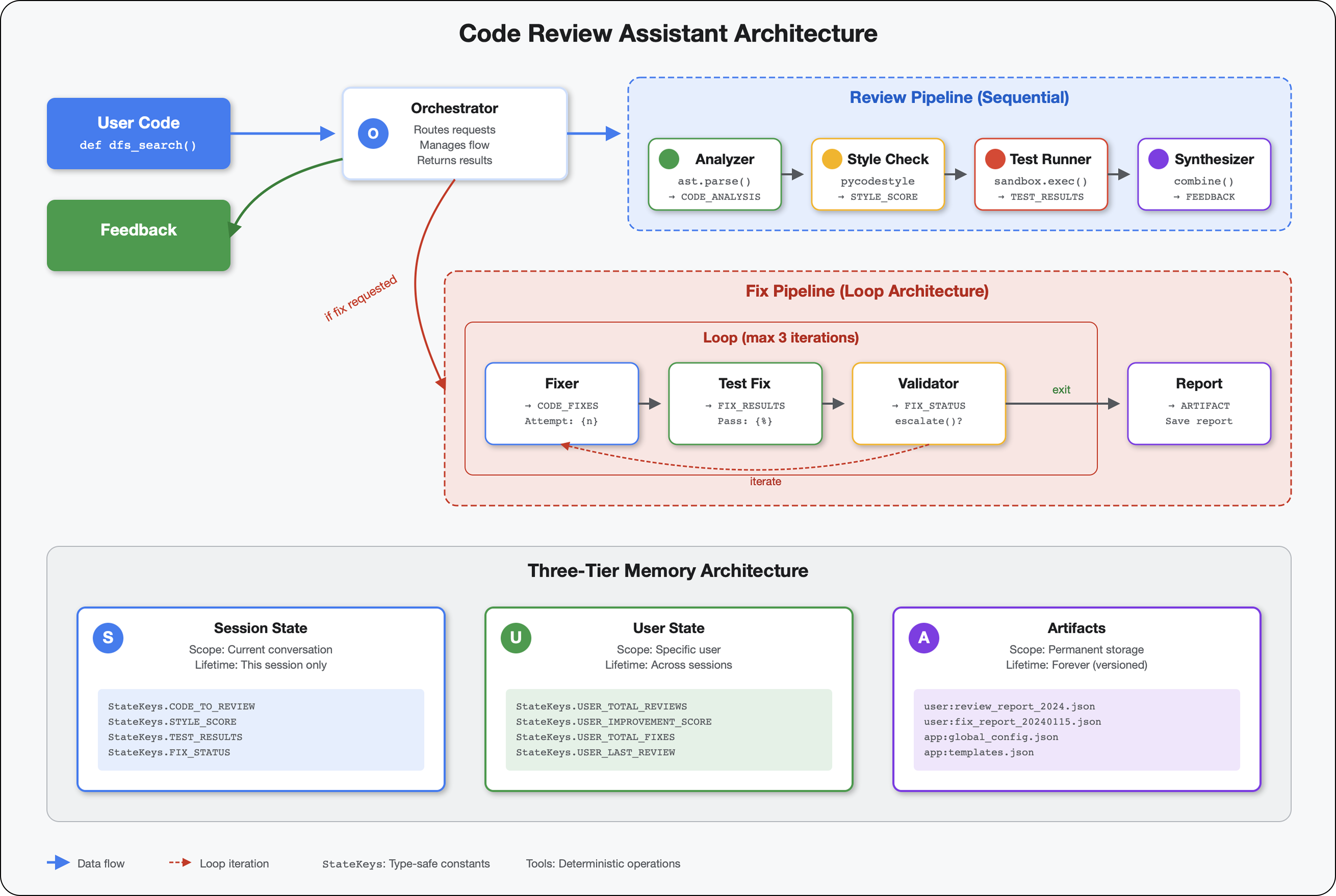
今天,您將從使用 AI 工具,進階到建構 AI 工具。您將建構多代理系統,該系統會:
- 確定性地分析程式碼結構
- 執行實際測試,驗證行為
- 使用實際的 Linter 驗證樣式是否符合規定
- 彙整調查結果,提供實用回饋
- 部署至 Google Cloud,並提供完整的觀測功能
2. 首次部署代理程式
開發人員的問題
「我瞭解 LLM,也用過 API,但如何從 Python 指令碼變成可擴充的正式版 AI 代理程式?」
讓我們正確設定環境,然後建構簡單的代理程式,瞭解基本概念,再深入探討生產模式,藉此回答這個問題。
請先完成基本設定
建立任何代理程式前,請先確認 Google Cloud 環境已就緒。
需要 Google Cloud 抵免額嗎?
點選 Google Cloud 控制台頂端的「啟用 Cloud Shell」 (這是 Cloud Shell 窗格頂端的終端機形狀圖示),
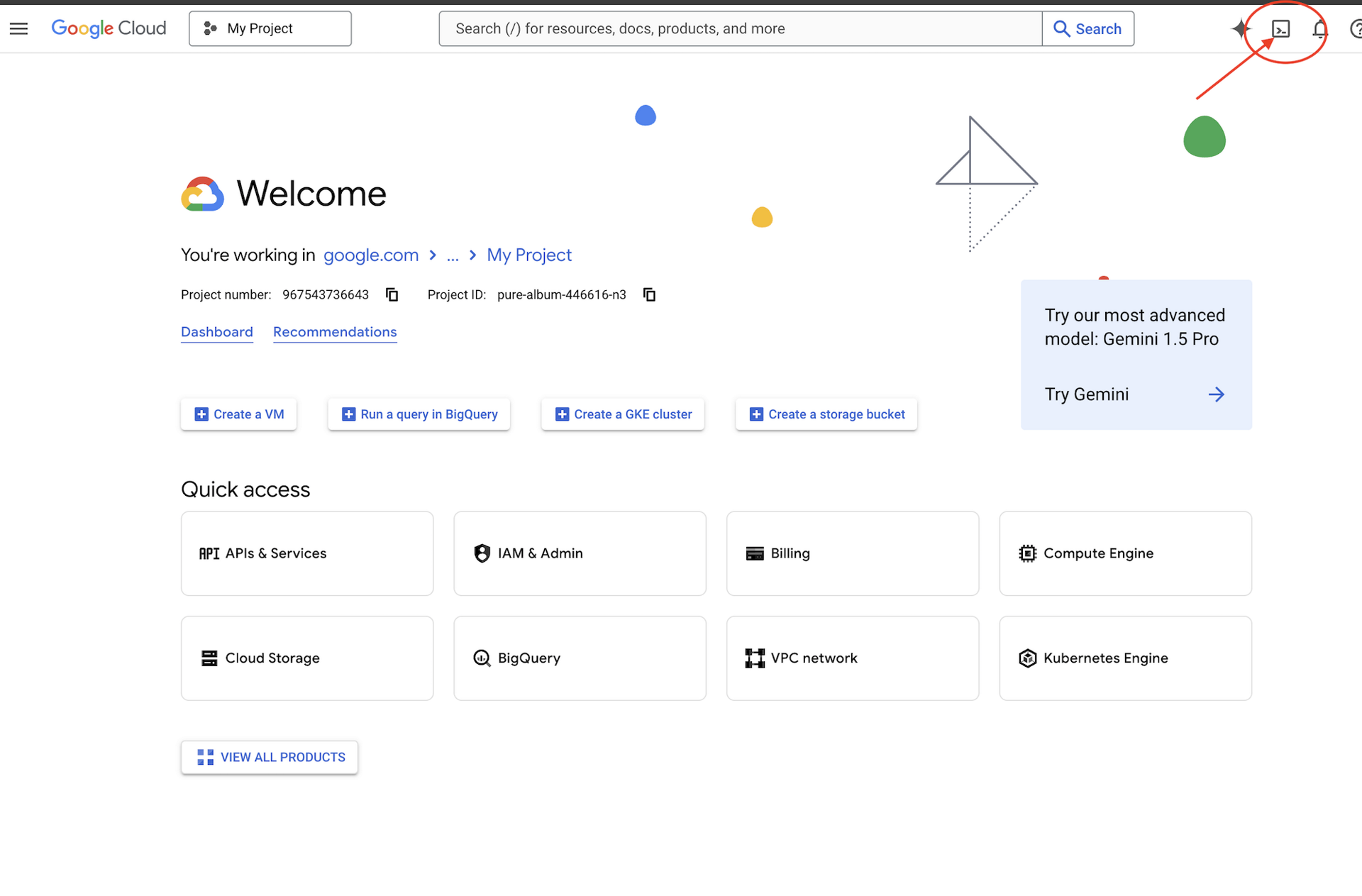
找出 Google Cloud 專案 ID:
- 開啟 Google Cloud 控制台:https://console.cloud.google.com
- 在頁面頂端的專案下拉式選單中,選取要用於本研討會的專案。
- 專案 ID 會顯示在資訊主頁的「專案資訊」資訊卡中
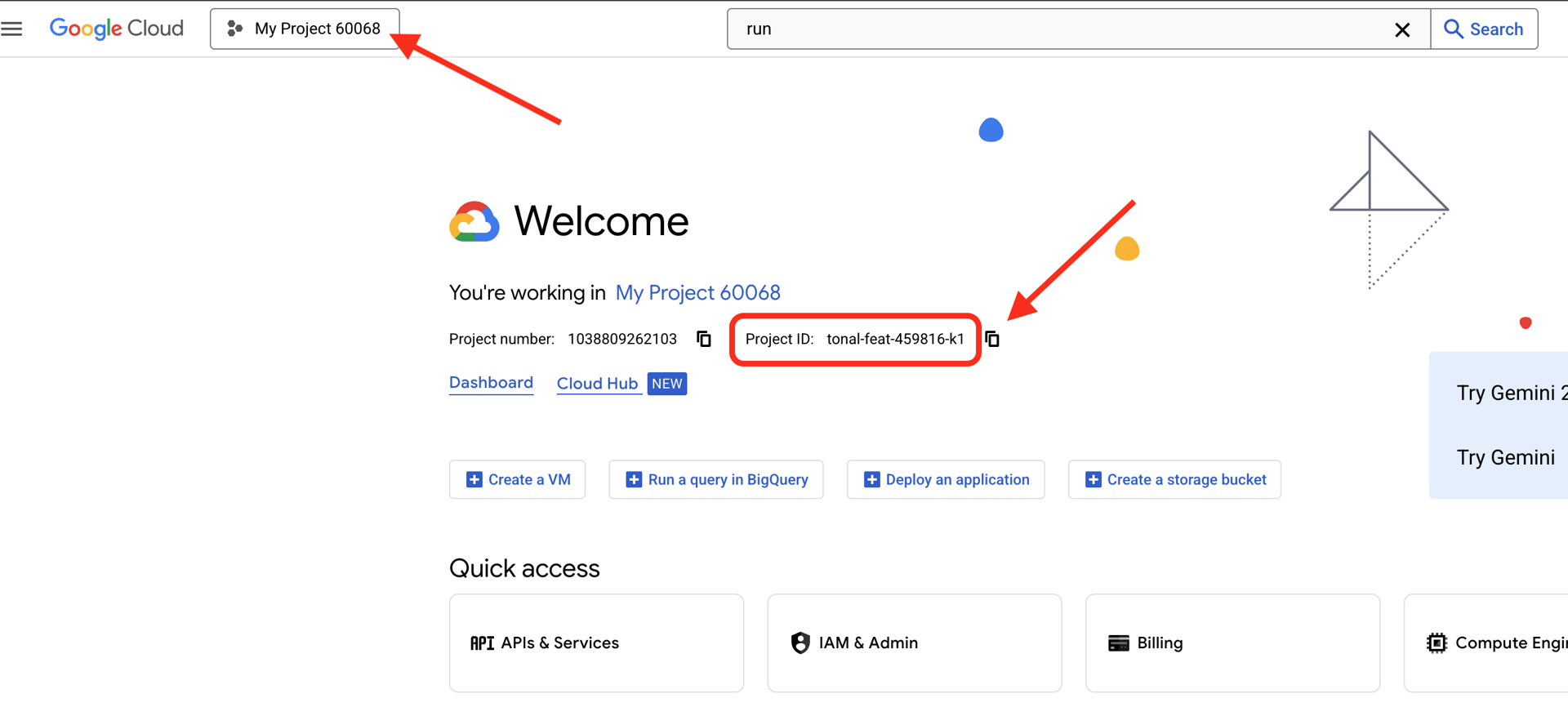
步驟 1:設定專案 ID
Cloud Shell 已設定 gcloud 指令列工具。執行下列指令來設定有效專案。這會使用 $GOOGLE_CLOUD_PROJECT 環境變數,系統會在 Cloud Shell 工作階段中自動為您設定這個變數。
gcloud config set project $GOOGLE_CLOUD_PROJECT
步驟 2:驗證設定
接著,請執行下列指令,確認專案設定正確無誤,且您已通過驗證。
# Confirm project is set
echo "Current project: $(gcloud config get-value project)"
# Check authentication status
gcloud auth list
您應該會看到列印的專案 ID,以及旁邊有 (ACTIVE) 的使用者帳戶。
如果帳戶未列為有效帳戶,或您收到驗證錯誤訊息,請執行下列指令登入:
gcloud auth application-default login
步驟 3:啟用必要 API
基本代理程式至少需要下列 API:
gcloud services enable \
aiplatform.googleapis.com \
compute.googleapis.com
這項作業可能需要幾分鐘才能完成。您會看到:
Operation "operations/..." finished successfully.
步驟 4:安裝 ADK
# Install the ADK CLI
pip install google-adk --upgrade
# Verify installation
adk --version
您應該會看到 1.15.0 以上的版本號碼。
現在建立基本虛擬服務專員
環境準備就緒後,我們來建立簡單的代理程式。
步驟 5:使用 ADK Create
adk create my_first_agent
按照互動式提示操作:
Choose a model for the root agent:
1. gemini-2.5-flash
2. Other models (fill later)
Choose model (1, 2): 1
1. Google AI
2. Vertex AI
Choose a backend (1, 2): 2
Enter Google Cloud project ID [auto-detected-from-gcloud]:
Enter Google Cloud region [us-central1]:
步驟 6:檢查建立的內容
cd my_first_agent
ls -la
您會看到三個檔案:
.env # Configuration (auto-populated with your project)
__init__.py # Package marker
agent.py # Your agent definition
步驟 7:快速檢查設定
# Verify the .env was created correctly
cat .env
# Should show something like:
# GOOGLE_CLOUD_PROJECT=your-project-id
# GOOGLE_CLOUD_LOCATION=us-central1
# GOOGLE_GENAI_USE_VERTEXAI=1
如果專案 ID 遺漏或有誤,請編輯 .env 檔案:
nano .env # or use your preferred editor
步驟 8:查看代理程式碼
cat agent.py
from google.adk.agents.llm_agent import Agent
root_agent = Agent(
model='gemini-2.5-flash',
name='root_agent',
description='A helpful assistant for user questions.',
instruction='Answer user questions to the best of your knowledge',
)
簡單、乾淨、極簡。這是代理程式的「Hello World」。
測試基本代理程式
步驟 9:執行代理程式
cd ..
adk run my_first_agent
您應該會看到類似下方的內容:
Log setup complete: /tmp/agents_log/agent.20250930_162430.log
To access latest log: tail -F /tmp/agents_log/agent.latest.log
[user]:
步驟 10:嘗試查詢
在執行 adk run 的終端機中,您會看到提示。輸入查詢:
[user]: Hey, what can you do?
[root_agent]: I can help answer questions, generate text, explain concepts, assist with problem-solving, and provide information on a wide range of topics. What would you like to know or discuss?
[user]: What's the current weather in Mountain View?
[root_agent]: I'm sorry, but I cannot provide real-time weather information as I don't have access to current data or weather services. To get the current weather in Mountain View, I recommend checking a weather website or app like weather.com or using a search engine.
請注意這項限制,因為這項函式無法存取目前的資料。讓我們進一步探討:
[user]: Review this Python code: def add(a, b): return a + b
[root_agent]: This is a simple Python function that adds two numbers. Here's my review:
**Strengths:**
- Clean and concise implementation
- Follows Python conventions for simple operations
- Clear function name that describes its purpose
**Suggestions for improvement:**
- Add a docstring to document the function
- Consider adding type hints for better code clarity
- You might want to handle edge cases
Here's an enhanced version:
def add(a: float, b: float) -> float:
"""Add two numbers and return their sum."""
return a + b
代理程式可以討論程式碼,但可以:
- 實際剖析 AST 以瞭解結構?
- 執行測試來驗證是否正常運作?
- 檢查樣式是否符合規定?
- 還記得先前的評論嗎?
否。這時就需要架構。
🏃🚪 使用
Ctrl+C
探索完畢後。
3. 準備正式版工作區
解決方案:可投入實作環境的架構
簡單的代理程式只是起點,實際運作的系統需要健全的架構。現在,我們將設定一個完整的專案,體現製作原則。
設定基礎
您已為基本代理程式設定 Google Cloud 專案。現在,我們來準備完整的正式版工作區,其中包含實際系統所需的所有工具、模式和基礎架構。
步驟 1:取得結構化專案
首先,請結束所有正在執行的 adk run,並使用 Ctrl+C 清理:
# Clean up the basic agent
cd ~ # Make sure you're not inside my_first_agent
rm -rf my_first_agent
# Get the production scaffold
git clone https://github.com/ayoisio/adk-code-review-assistant.git
cd adk-code-review-assistant
git checkout codelab
步驟 2:建立並啟用虛擬環境
# Create the virtual environment
python -m venv .venv
# Activate it
# On macOS/Linux:
source .venv/bin/activate
# On Windows:
# .venv\Scripts\activate
驗證:提示詞開頭現在應會顯示 (.venv)。
步驟 3:安裝依附元件
pip install -r code_review_assistant/requirements.txt
# Install the package in editable mode (enables imports)
pip install -e .
這會安裝:
google-adk- ADK 架構pycodestyle- 用於 PEP 8 檢查vertexai- 適用於雲端部署作業- 其他生產依附元件
-e 標記可讓您從任何位置匯入 code_review_assistant 模組。
步驟 4:設定環境
# Copy the example environment file
cp .env.example .env
# Edit .env and replace the placeholders:
# - GOOGLE_CLOUD_PROJECT=your-project-id → your actual project ID
# - Keep other defaults as-is
驗證:檢查設定:
cat .env
應該顯示:
GOOGLE_CLOUD_PROJECT=your-actual-project-id
GOOGLE_CLOUD_LOCATION=us-central1
GOOGLE_GENAI_USE_VERTEXAI=TRUE
步驟 5:確認驗證
由於您先前已執行 gcloud auth,請驗證下列事項:
# Check current authentication
gcloud auth list
# Should show your account with (ACTIVE)
# If not, run:
gcloud auth application-default login
步驟 6:啟用其他正式版 API
我們已啟用基本 API。現在新增正式版:
gcloud services enable \
sqladmin.googleapis.com \
run.googleapis.com \
cloudbuild.googleapis.com \
artifactregistry.googleapis.com \
storage.googleapis.com \
cloudtrace.googleapis.com
這項做法可提供以下優勢:
- SQL 管理員:使用 Cloud Run 時適用於 Cloud SQL
- Cloud Run:適用於無伺服器部署作業
- Cloud Build:用於自動化部署
- Artifact Registry:適用於容器映像檔
- Cloud Storage:用於構件和暫存
- Cloud Trace:用於可觀測性
步驟 7:建立 Artifact Registry 存放區
我們的部署作業會建構需要主機的容器映像檔:
gcloud artifacts repositories create code-review-assistant-repo \
--repository-format=docker \
--location=us-central1 \
--description="Docker repository for Code Review Assistant"
畫面上會顯示下列訊息:
Created repository [code-review-assistant-repo].
如果該目錄已存在 (可能是先前嘗試時建立),請忽略錯誤訊息。
步驟 8:授予 IAM 權限
# Get your project number
PROJECT_NUMBER=$(gcloud projects describe $GOOGLE_CLOUD_PROJECT \
--format="value(projectNumber)")
# Define the service account
SERVICE_ACCOUNT="${PROJECT_NUMBER}@cloudbuild.gserviceaccount.com"
# Grant necessary roles
gcloud projects add-iam-policy-binding $GOOGLE_CLOUD_PROJECT \
--member="serviceAccount:${SERVICE_ACCOUNT}" \
--role="roles/run.admin"
gcloud projects add-iam-policy-binding $GOOGLE_CLOUD_PROJECT \
--member="serviceAccount:${SERVICE_ACCOUNT}" \
--role="roles/iam.serviceAccountUser"
gcloud projects add-iam-policy-binding $GOOGLE_CLOUD_PROJECT \
--member="serviceAccount:${SERVICE_ACCOUNT}" \
--role="roles/cloudsql.admin"
gcloud projects add-iam-policy-binding $GOOGLE_CLOUD_PROJECT \
--member="serviceAccount:${SERVICE_ACCOUNT}" \
--role="roles/storage.admin"
每個指令都會輸出:
Updated IAM policy for project [your-project-id].
你的成就
現在正式版工作區已準備就緒:
✅ 已設定及驗證 Google Cloud 專案
✅ 已測試基本代理程式,瞭解限制
✅ 已準備好包含策略性預留位置的專案程式碼
✅ 已在虛擬環境中隔離依附元件
✅ 已啟用所有必要 API
✅ 已準備好用於部署的 Container Registry
✅ 已正確設定 IAM 權限
✅ 已正確設定環境變數
現在您已準備好運用確定性工具、狀態管理和適當的架構,建構真正的 AI 系統。
4. 建立第一個代理程式
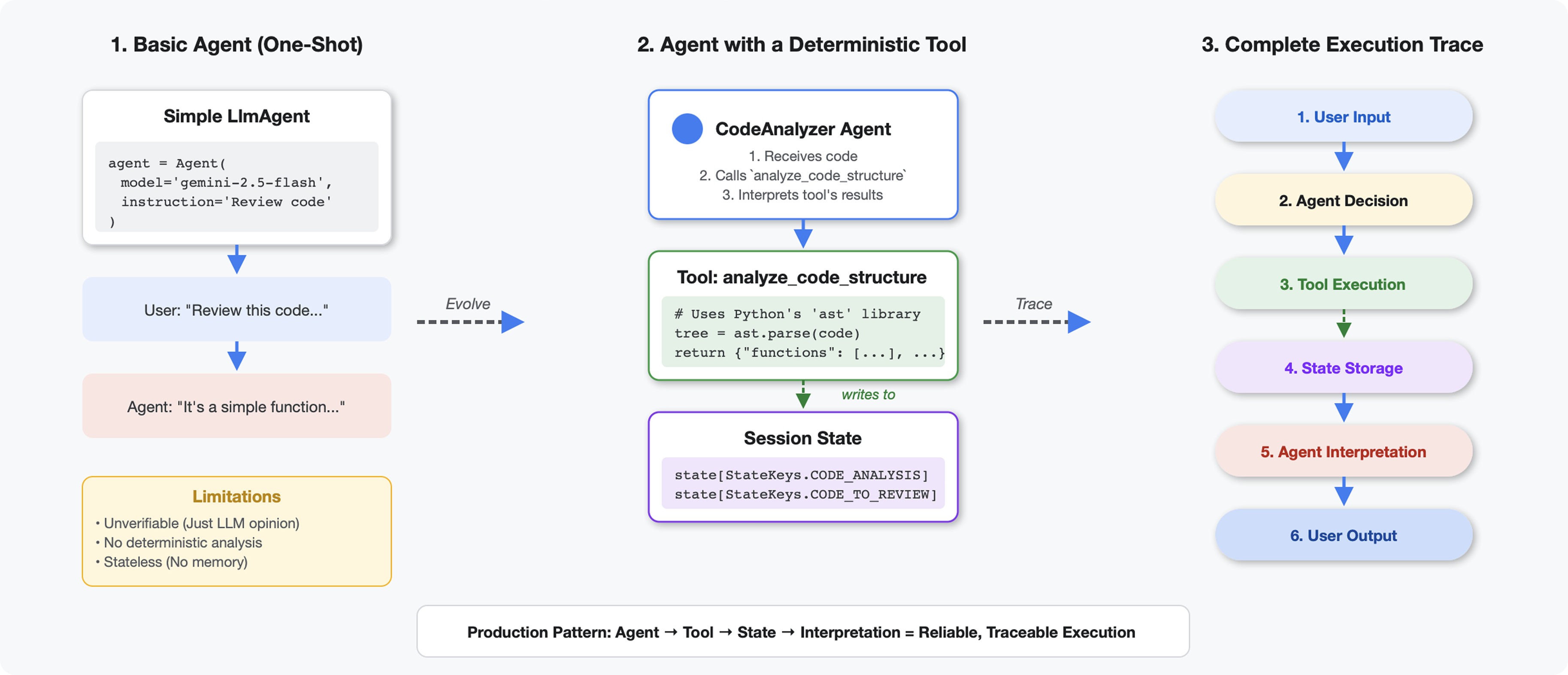
工具與 LLM 的差異
當您詢問 LLM「這段程式碼中有多少函式?」時,LLM 會使用模式比對和估算功能。使用呼叫 Python ast.parse() 的工具時,系統會剖析實際的語法樹狀結構,不會進行任何猜測,每次都會產生相同結果。
本節會建構工具,以決定性方式分析程式碼結構,然後將其連結至知道何時叫用該工具的代理程式。
步驟 1:瞭解 Scaffold
現在來看看您要填寫的結構。
👉 開啟
code_review_assistant/tools.py
您會看到 analyze_code_structure 函式,其中包含標示程式碼新增位置的預留位置註解。函式已具備基本結構,您將逐步強化函式。
步驟 2:新增狀態儲存空間
狀態儲存空間可讓管道中的其他代理程式存取工具結果,不必重新執行分析。
👉 尋找:
# MODULE_4_STEP_2_ADD_STATE_STORAGE
👉 將該單行程式碼替換為:
# Store code and analysis for other agents to access
tool_context.state[StateKeys.CODE_TO_REVIEW] = code
tool_context.state[StateKeys.CODE_ANALYSIS] = analysis
tool_context.state[StateKeys.CODE_LINE_COUNT] = len(code.splitlines())
步驟 3:使用執行緒集區新增非同步剖析功能
我們的工具需要剖析 AST,但不能封鎖其他作業。讓我們使用執行緒集區新增非同步執行作業。
👉 尋找:
# MODULE_4_STEP_3_ADD_ASYNC
👉 將該單行程式碼替換為:
# Parse in thread pool to avoid blocking the event loop
loop = asyncio.get_event_loop()
with ThreadPoolExecutor() as executor:
tree = await loop.run_in_executor(executor, ast.parse, code)
步驟 4:擷取完整資訊
現在,讓我們擷取類別、匯入項目和詳細指標,也就是完成程式碼審查所需的一切。
👉 尋找:
# MODULE_4_STEP_4_EXTRACT_DETAILS
👉 將該單行程式碼替換為:
# Extract comprehensive structural information
analysis = await loop.run_in_executor(
executor, _extract_code_structure, tree, code
)
👉 驗證:函式
analyze_code_structure
tools.py
的中央主體如下所示:
# Parse in thread pool to avoid blocking the event loop
loop = asyncio.get_event_loop()
with ThreadPoolExecutor() as executor:
tree = await loop.run_in_executor(executor, ast.parse, code)
# Extract comprehensive structural information
analysis = await loop.run_in_executor(
executor, _extract_code_structure, tree, code
)
# Store code and analysis for other agents to access
tool_context.state[StateKeys.CODE_TO_REVIEW] = code
tool_context.state[StateKeys.CODE_ANALYSIS] = analysis
tool_context.state[StateKeys.CODE_LINE_COUNT] = len(code.splitlines())
👉 現在請捲動至
tools.py
並找到:
# MODULE_4_STEP_4_HELPER_FUNCTION
👉 將該單行程式碼替換為完整的輔助函式:
def _extract_code_structure(tree: ast.AST, code: str) -> Dict[str, Any]:
"""
Helper function to extract structural information from AST.
Runs in thread pool for CPU-bound work.
"""
functions = []
classes = []
imports = []
docstrings = []
for node in ast.walk(tree):
if isinstance(node, ast.FunctionDef):
func_info = {
'name': node.name,
'args': [arg.arg for arg in node.args.args],
'lineno': node.lineno,
'has_docstring': ast.get_docstring(node) is not None,
'is_async': isinstance(node, ast.AsyncFunctionDef),
'decorators': [d.id for d in node.decorator_list
if isinstance(d, ast.Name)]
}
functions.append(func_info)
if func_info['has_docstring']:
docstrings.append(f"{node.name}: {ast.get_docstring(node)[:50]}...")
elif isinstance(node, ast.ClassDef):
methods = []
for item in node.body:
if isinstance(item, ast.FunctionDef):
methods.append(item.name)
class_info = {
'name': node.name,
'lineno': node.lineno,
'methods': methods,
'has_docstring': ast.get_docstring(node) is not None,
'base_classes': [base.id for base in node.bases
if isinstance(base, ast.Name)]
}
classes.append(class_info)
elif isinstance(node, ast.Import):
for alias in node.names:
imports.append({
'module': alias.name,
'alias': alias.asname,
'type': 'import'
})
elif isinstance(node, ast.ImportFrom):
imports.append({
'module': node.module or '',
'names': [alias.name for alias in node.names],
'type': 'from_import',
'level': node.level
})
return {
'functions': functions,
'classes': classes,
'imports': imports,
'docstrings': docstrings,
'metrics': {
'line_count': len(code.splitlines()),
'function_count': len(functions),
'class_count': len(classes),
'import_count': len(imports),
'has_main': any(f['name'] == 'main' for f in functions),
'has_if_main': '__main__' in code,
'avg_function_length': _calculate_avg_function_length(tree)
}
}
def _calculate_avg_function_length(tree: ast.AST) -> float:
"""Calculate average function length in lines."""
function_lengths = []
for node in ast.walk(tree):
if isinstance(node, ast.FunctionDef):
if hasattr(node, 'end_lineno') and hasattr(node, 'lineno'):
length = node.end_lineno - node.lineno + 1
function_lengths.append(length)
if function_lengths:
return sum(function_lengths) / len(function_lengths)
return 0.0
步驟 5:與服務專員連線
現在,我們將工具連結至代理程式,讓代理程式知道何時使用工具,以及如何解讀結果。
👉 開啟
code_review_assistant/sub_agents/review_pipeline/code_analyzer.py
👉 尋找:
# MODULE_4_STEP_5_CREATE_AGENT
👉 將該單行程式碼替換為完整的正式版代理程式:
code_analyzer_agent = Agent(
name="CodeAnalyzer",
model=config.worker_model,
description="Analyzes Python code structure and identifies components",
instruction="""You are a code analysis specialist responsible for understanding code structure.
Your task:
1. Take the code submitted by the user (it will be provided in the user message)
2. Use the analyze_code_structure tool to parse and analyze it
3. Pass the EXACT code to your tool - do not modify, fix, or "improve" it
4. Identify all functions, classes, imports, and structural patterns
5. Note any syntax errors or structural issues
6. Store the analysis in state for other agents to use
CRITICAL:
- Pass the code EXACTLY as provided to the analyze_code_structure tool
- Do not fix syntax errors, even if obvious
- Do not add missing imports or fix indentation
- The goal is to analyze what IS there, not what SHOULD be there
When calling the tool, pass the code as a string to the 'code' parameter.
If the analysis fails due to syntax errors, clearly report the error location and type.
Provide a clear summary including:
- Number of functions and classes found
- Key structural observations
- Any syntax errors or issues detected
- Overall code organization assessment""",
tools=[FunctionTool(func=analyze_code_structure)],
output_key="structure_analysis_summary"
)
測試程式碼分析器
現在請確認分析器是否正常運作。
👉 執行測試指令碼:
python tests/test_code_analyzer.py
測試指令碼會使用 python-dotenv 從 .env 檔案自動載入設定,因此不需要手動設定環境變數。
預期的輸出內容:
INFO:code_review_assistant.config:Code Review Assistant Configuration Loaded:
INFO:code_review_assistant.config: - GCP Project: your-project-id
INFO:code_review_assistant.config: - Artifact Bucket: gs://your-project-artifacts
INFO:code_review_assistant.config: - Models: worker=gemini-2.5-flash, critic=gemini-2.5-pro
Testing code analyzer...
INFO:code_review_assistant.tools:Tool: Analysis complete - 2 functions, 1 classes
=== Analyzer Response ===
The analysis of the provided code shows the following:
* **Functions Found:** 2
* `add(a, b)`: A global function at line 2.
* `multiply(self, x, y)`: A method within the `Calculator` class.
* **Classes Found:** 1
* `Calculator`: A class defined at line 5. Contains one method, `multiply`.
* **Imports:** 0
* **Structural Patterns:** The code defines one global function and one class
with a single method. Both are simple, each with a single return statement.
* **Syntax Errors/Issues:** No syntax errors detected.
* **Overall Code Organization:** The code is well-organized for its small size,
clearly defining a function and a class with a method.
剛才發生了什麼事:
- 測試指令碼已自動載入
.env設定 - 您的
analyze_code_structure()工具使用 Python 的 AST 剖析程式碼 _extract_code_structure()輔助程式會擷取函式、類別和指標- 結果會使用
StateKeys常數儲存在工作階段狀態中 - 程式碼分析器代理程式解讀結果並提供摘要
疑難排解:
- 「No module named ‘code_review_assistant’」(沒有名為「code_review_assistant」的模組):從專案根目錄執行
pip install -e . - 「缺少金鑰輸入引數」:確認
.env具有GOOGLE_CLOUD_PROJECT、GOOGLE_CLOUD_LOCATION和GOOGLE_GENAI_USE_VERTEXAI=true
建構項目
您現在擁有可投入生產的程式碼分析器,具備下列功能:
✅ 剖析實際的 Python AST - 具決定性,而非模式比對
✅ 將結果儲存在狀態中 - 其他代理程式可以存取分析結果
✅ 非同步執行 - 不會封鎖其他工具
✅ 擷取完整資訊 - 函式、類別、匯入項目、指標
✅ 妥善處理錯誤 - 報告語法錯誤和行號
✅ 連結至代理程式 - LLM 知道何時及如何使用
掌握基本概念
工具與代理程式:
- 工具會執行確定性工作 (AST 剖析)
- 代理程式會決定何時使用工具及解讀結果
傳回值與狀態:
- 回覆:LLM 立即看到的內容
- 狀態:其他代理程式會保留哪些內容
狀態鍵常數:
- 避免多代理系統發生錯別字
- 做為代理程式之間的合約
- 代理人分享資料時至關重要
非同步 + 執行緒集區:
async def可讓工具暫停執行- 執行緒集區會在背景執行 CPU 繫結工作
- 兩者共同維持事件迴圈的回應性
輔助函式:
- 將同步輔助程式與非同步工具分開
- 讓程式碼可測試及重複使用
服務專員指示:
- 詳細指令可避免常見的 LLM 錯誤
- 明確說明「不要」做什麼 (不要修正程式碼)
- 清除工作流程步驟,確保一致性
後續步驟
在單元 5 中,您將新增:
- 樣式檢查工具,可從狀態讀取程式碼
- 實際執行測試的測試執行器
- 意見回饋綜合分析,整合所有分析結果
您會瞭解狀態如何透過循序管道流動,以及多個代理程式讀取及寫入相同資料時,常數模式為何重要。
5. 建構管道:多個代理程式共同運作
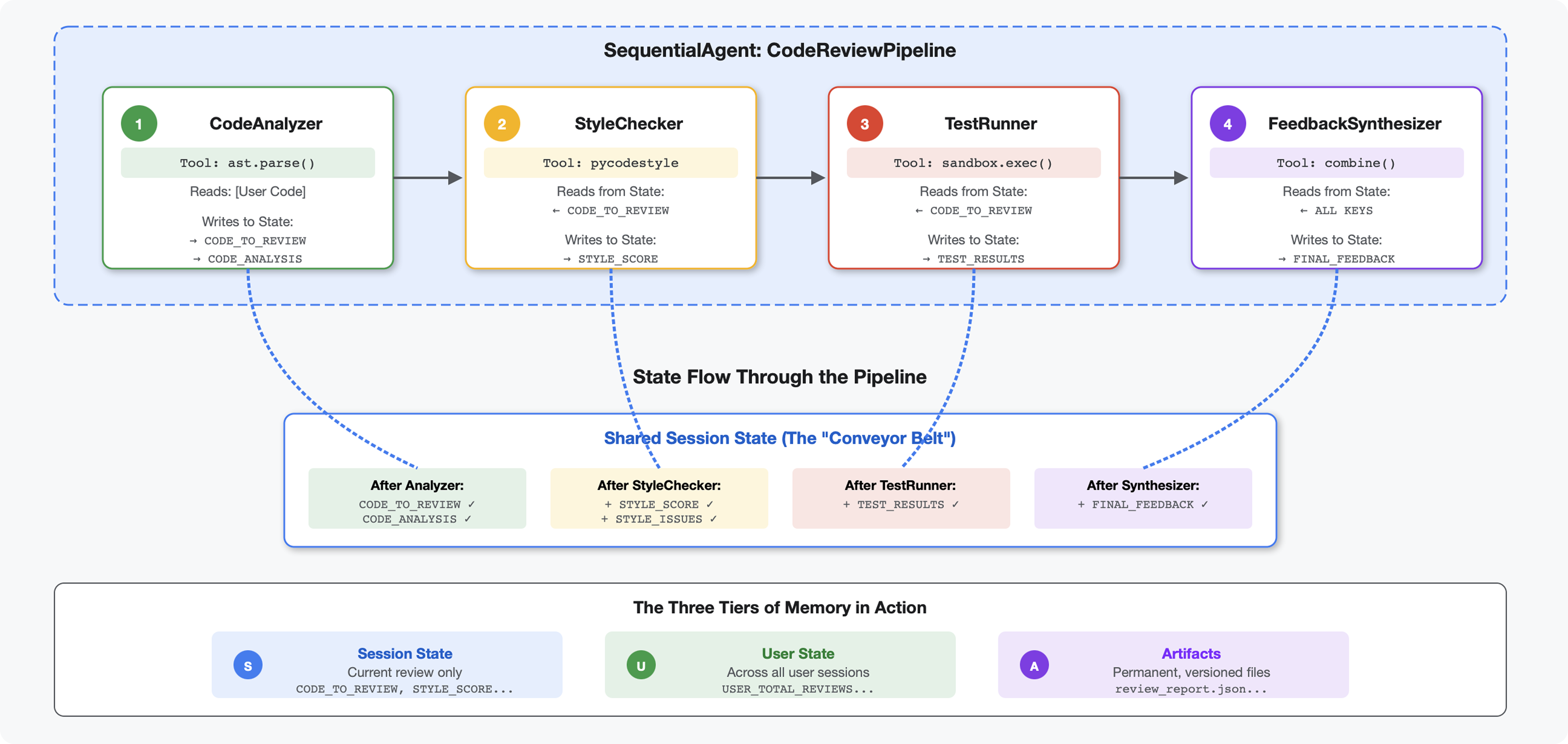
簡介
在單元 4 中,您建構了可分析程式碼結構的單一代理程式。但要進行全面程式碼審查,不只是剖析程式碼,還需要檢查樣式、執行測試,以及綜合分析智慧回饋。
這個模組會建構4 個代理程式的管道,這些代理程式會依序協作,各自提供專業分析:
- 程式碼分析器 (來自第 4 堂課) - 剖析結構
- 樣式檢查器 - 找出違反樣式的內容
- 測試執行工具 - 執行及驗證測試
- 意見回饋綜合分析器 - 將所有內容整合為可執行的意見回饋
重要概念:狀態即通訊管道。每個代理程式都會讀取先前代理程式寫入狀態的內容、加入自己的分析,並將經過擴充的狀態傳遞給下一個代理程式。當多個代理程式共用資料時,第 4 單元的常數模式就變得至關重要。
建構內容的預覽畫面:提交雜亂的程式碼 → 觀察狀態在 4 個代理程式間流動 → 根據過去的模式接收包含個人化意見回饋的完整報表。
步驟 1:新增樣式檢查工具 + 代理程式
樣式檢查工具會使用 pycodestyle 找出違反 PEP 8 的情況,這是一種確定性 Linter,而非以 LLM 為基礎的解讀。
新增樣式檢查工具
👉 開啟
code_review_assistant/tools.py
👉 尋找:
# MODULE_5_STEP_1_STYLE_CHECKER_TOOL
👉 將該單行程式碼替換為:
async def check_code_style(code: str, tool_context: ToolContext) -> Dict[str, Any]:
"""
Checks code style compliance using pycodestyle (PEP 8).
Args:
code: Python source code to check (or will retrieve from state)
tool_context: ADK tool context
Returns:
Dictionary containing style score and issues
"""
logger.info("Tool: Checking code style...")
try:
# Retrieve code from state if not provided
if not code:
code = tool_context.state.get(StateKeys.CODE_TO_REVIEW, '')
if not code:
return {
"status": "error",
"message": "No code provided or found in state"
}
# Run style check in thread pool
loop = asyncio.get_event_loop()
with ThreadPoolExecutor() as executor:
result = await loop.run_in_executor(
executor, _perform_style_check, code
)
# Store results in state
tool_context.state[StateKeys.STYLE_SCORE] = result['score']
tool_context.state[StateKeys.STYLE_ISSUES] = result['issues']
tool_context.state[StateKeys.STYLE_ISSUE_COUNT] = result['issue_count']
logger.info(f"Tool: Style check complete - Score: {result['score']}/100, "
f"Issues: {result['issue_count']}")
return result
except Exception as e:
error_msg = f"Style check failed: {str(e)}"
logger.error(f"Tool: {error_msg}", exc_info=True)
# Set default values on error
tool_context.state[StateKeys.STYLE_SCORE] = 0
tool_context.state[StateKeys.STYLE_ISSUES] = []
return {
"status": "error",
"message": error_msg,
"score": 0
}
👉 現在請捲動至檔案結尾,然後找出:
# MODULE_5_STEP_1_STYLE_HELPERS
👉 將該單行取代為輔助函式:
def _perform_style_check(code: str) -> Dict[str, Any]:
"""Helper to perform style check in thread pool."""
import io
import sys
with tempfile.NamedTemporaryFile(mode='w', suffix='.py', delete=False) as tmp:
tmp.write(code)
tmp_path = tmp.name
try:
# Capture stdout to get pycodestyle output
old_stdout = sys.stdout
sys.stdout = captured_output = io.StringIO()
style_guide = pycodestyle.StyleGuide(
quiet=False, # We want output
max_line_length=100,
ignore=['E501', 'W503']
)
result = style_guide.check_files([tmp_path])
# Restore stdout
sys.stdout = old_stdout
# Parse captured output
output = captured_output.getvalue()
issues = []
for line in output.strip().split('\n'):
if line and ':' in line:
parts = line.split(':', 4)
if len(parts) >= 4:
try:
issues.append({
'line': int(parts[1]),
'column': int(parts[2]),
'code': parts[3].split()[0] if len(parts) > 3 else 'E000',
'message': parts[3].strip() if len(parts) > 3 else 'Unknown error'
})
except (ValueError, IndexError):
pass
# Add naming convention checks
try:
tree = ast.parse(code)
naming_issues = _check_naming_conventions(tree)
issues.extend(naming_issues)
except SyntaxError:
pass # Syntax errors will be caught elsewhere
# Calculate weighted score
score = _calculate_style_score(issues)
return {
"status": "success",
"score": score,
"issue_count": len(issues),
"issues": issues[:10], # First 10 issues
"summary": f"Style score: {score}/100 with {len(issues)} violations"
}
finally:
if os.path.exists(tmp_path):
os.unlink(tmp_path)
def _check_naming_conventions(tree: ast.AST) -> List[Dict[str, Any]]:
"""Check PEP 8 naming conventions."""
naming_issues = []
for node in ast.walk(tree):
if isinstance(node, ast.FunctionDef):
# Skip private/protected methods and __main__
if not node.name.startswith('_') and node.name != node.name.lower():
naming_issues.append({
'line': node.lineno,
'column': node.col_offset,
'code': 'N802',
'message': f"N802 function name '{node.name}' should be lowercase"
})
elif isinstance(node, ast.ClassDef):
# Check if class name follows CapWords convention
if not node.name[0].isupper() or '_' in node.name:
naming_issues.append({
'line': node.lineno,
'column': node.col_offset,
'code': 'N801',
'message': f"N801 class name '{node.name}' should use CapWords convention"
})
return naming_issues
def _calculate_style_score(issues: List[Dict[str, Any]]) -> int:
"""Calculate weighted style score based on violation severity."""
if not issues:
return 100
# Define weights by error type
weights = {
'E1': 10, # Indentation errors
'E2': 3, # Whitespace errors
'E3': 5, # Blank line errors
'E4': 8, # Import errors
'E5': 5, # Line length
'E7': 7, # Statement errors
'E9': 10, # Syntax errors
'W2': 2, # Whitespace warnings
'W3': 2, # Blank line warnings
'W5': 3, # Line break warnings
'N8': 7, # Naming conventions
}
total_deduction = 0
for issue in issues:
code_prefix = issue['code'][:2] if len(issue['code']) >= 2 else 'E2'
weight = weights.get(code_prefix, 3)
total_deduction += weight
# Cap at 100 points deduction
return max(0, 100 - min(total_deduction, 100))
新增樣式檢查代理程式
👉 開啟
code_review_assistant/sub_agents/review_pipeline/style_checker.py
👉 尋找:
# MODULE_5_STEP_1_INSTRUCTION_PROVIDER
👉 將該單行程式碼替換為:
async def style_checker_instruction_provider(context: ReadonlyContext) -> str:
"""Dynamic instruction provider that injects state variables."""
template = """You are a code style expert focused on PEP 8 compliance.
Your task:
1. Use the check_code_style tool to validate PEP 8 compliance
2. The tool will retrieve the ORIGINAL code from state automatically
3. Report violations exactly as found
4. Present the results clearly and confidently
CRITICAL:
- The tool checks the code EXACTLY as provided by the user
- Do not suggest the code was modified or fixed
- Report actual violations found in the original code
- If there are style issues, they should be reported honestly
Call the check_code_style tool with an empty string for the code parameter,
as the tool will retrieve the code from state automatically.
When presenting results based on what the tool returns:
- State the exact score from the tool results
- If score >= 90: "Excellent style compliance!"
- If score 70-89: "Good style with minor improvements needed"
- If score 50-69: "Style needs attention"
- If score < 50: "Significant style improvements needed"
List the specific violations found (the tool will provide these):
- Show line numbers, error codes, and messages
- Focus on the top 10 most important issues
Previous analysis: {structure_analysis_summary}
Format your response as:
## Style Analysis Results
- Style Score: [exact score]/100
- Total Issues: [count]
- Assessment: [your assessment based on score]
## Top Style Issues
[List issues with line numbers and descriptions]
## Recommendations
[Specific fixes for the most critical issues]"""
return await instructions_utils.inject_session_state(template, context)
👉 尋找:
# MODULE_5_STEP_1_STYLE_CHECKER_AGENT
👉 將該單行程式碼替換為:
style_checker_agent = Agent(
name="StyleChecker",
model=config.worker_model,
description="Checks Python code style against PEP 8 guidelines",
instruction=style_checker_instruction_provider,
tools=[FunctionTool(func=check_code_style)],
output_key="style_check_summary"
)
步驟 2:新增 Test Runner Agent
測試執行器會產生全面測試,並使用內建的程式碼執行器執行測試。
👉 開啟
code_review_assistant/sub_agents/review_pipeline/test_runner.py
👉 尋找:
# MODULE_5_STEP_2_INSTRUCTION_PROVIDER
👉 將該單行程式碼替換為:
async def test_runner_instruction_provider(context: ReadonlyContext) -> str:
"""Dynamic instruction provider that injects the code_to_review directly."""
template = """You are a testing specialist who creates and runs tests for Python code.
THE CODE TO TEST IS:
{code_to_review}
YOUR TASK:
1. Understand what the function appears to do based on its name and structure
2. Generate comprehensive tests (15-20 test cases)
3. Execute the tests using your code executor
4. Analyze results to identify bugs vs expected behavior
5. Output a detailed JSON analysis
TESTING METHODOLOGY:
- Test with the most natural interpretation first
- When something fails, determine if it's a bug or unusual design
- Test edge cases, boundaries, and error scenarios
- Document any surprising behavior
Execute your tests and output ONLY valid JSON with this structure:
- "test_summary": object with "total_tests_run", "tests_passed", "tests_failed", "tests_with_errors", "critical_issues_found"
- "critical_issues": array of objects, each with "type", "description", "example_input", "expected_behavior", "actual_behavior", "severity"
- "test_categories": object with "basic_functionality", "edge_cases", "error_handling" (each containing "passed", "failed", "errors" counts)
- "function_behavior": object with "apparent_purpose", "actual_interface", "unexpected_requirements"
- "verdict": object with "status" (WORKING/BUGGY/BROKEN), "confidence" (high/medium/low), "recommendation"
Do NOT output the test code itself, only the JSON analysis."""
return await instructions_utils.inject_session_state(template, context)
👉 尋找:
# MODULE_5_STEP_2_TEST_RUNNER_AGENT
👉 將該單行程式碼替換為:
test_runner_agent = Agent(
name="TestRunner",
model=config.critic_model,
description="Generates and runs tests for Python code using safe code execution",
instruction=test_runner_instruction_provider,
code_executor=BuiltInCodeExecutor(),
output_key="test_execution_summary"
)
步驟 3:瞭解跨工作階段學習的記憶體
建構意見回饋合成器之前,您需要瞭解「狀態」和「記憶體」之間的差異,這兩種儲存機制用途不同。
狀態與記憶體:主要區別
我們以程式碼審查的具體範例來說明:
狀態 (僅限目前工作階段):
# Data from THIS review session
tool_context.state[StateKeys.STYLE_ISSUES] = [
{"line": 5, "code": "E231", "message": "missing whitespace"},
{"line": 12, "code": "E701", "message": "multiple statements"}
]
- 範圍:僅限這個對話
- 用途:在目前管道中的代理程式之間傳遞資料
- 居住在:
Session物件 - 生命週期:工作階段結束時捨棄
記憶體 (所有過往工作階段):
# Learned from 50 previous reviews
"User frequently forgets docstrings on helper functions"
"User tends to write long functions (avg 45 lines)"
"User improved error handling after feedback in session #23"
- 範圍:這位使用者的所有過往工作階段
- 用途:瞭解模式、提供個人化意見回饋
- 居住地:
MemoryService - 生命週期:跨工作階段保留,可供搜尋
為什麼需要同時提供這兩種意見回饋:
假設合成器會產生意見回饋:
僅使用「州」(目前審查):
"Function `calculate_total` has no docstring."
一般機械式意見回饋。
使用狀態 + 記憶體 (目前和過去的模式):
"Function `calculate_total` has no docstring. This is the 4th review
where helper functions lacked documentation. Consider adding docstrings
as you write functions, not afterwards - you mentioned in our last
session that you find it easier that way."
個人化、比對內容、參考資料會隨著時間越來越準確。
如要部署至正式環境,您有多種選項:
選項 1:VertexAiMemoryBankService (進階)
- 功能:運用 LLM 從對話中擷取有意義的事實
- 搜尋:語意搜尋 (理解意義,而不只是關鍵字)
- 記憶體管理:隨著時間推移,自動整合及更新記憶體
- 必要條件:Google Cloud 專案 + Agent Engine 設定
- 適用情況:您希望回憶錄能不斷演進,並提供精緻的個人化體驗
- 範例:「使用者偏好函式程式設計」(從 10 則有關程式碼樣式的對話中擷取)
選項 2:繼續使用 InMemoryMemoryService + 持續性工作階段
- 用途:儲存關鍵字搜尋的完整對話記錄
- 搜尋:在過去的階段中進行基本關鍵字比對
- 記憶體管理:你可以控管要儲存的內容 (透過
add_session_to_memory) - 必要條件:僅限持續性
SessionService(例如VertexAiSessionService或DatabaseSessionService) - 適用情況:您需要簡單搜尋過往對話,且不需要 LLM 處理
- 範例:搜尋「docstring」會傳回所有提及該字詞的會議
記憶體如何填入資料
每次完成程式碼審查後:
# At the end of a session (typically in your application code)
await memory_service.add_session_to_memory(session)
會發生什麼情況:
- InMemoryMemoryService:儲存關鍵字搜尋的完整工作階段事件
- VertexAiMemoryBankService:LLM 會擷取重要事實,並與現有記憶內容合併
日後的工作階段可以查詢:
# In a tool, search for relevant past feedback
results = tool_context.search_memory("feedback about docstrings")
步驟 4:新增意見回饋綜合工具和代理程式
意見回饋合成器是管道中最精密的代理程式。這項工具會協調三種工具、使用動態指令,並結合狀態、記憶體和構件。
新增三種合成器工具
👉 開啟
code_review_assistant/tools.py
👉 尋找:
# MODULE_5_STEP_4_SEARCH_PAST_FEEDBACK
👉 Replace with Tool 1 - Memory Search (production version):
async def search_past_feedback(developer_id: str, tool_context: ToolContext) -> Dict[str, Any]:
"""
Search for past feedback in memory service.
Args:
developer_id: ID of the developer (defaults to "default_user")
tool_context: ADK tool context with potential memory service access
Returns:
Dictionary containing feedback search results
"""
logger.info(f"Tool: Searching for past feedback for developer {developer_id}...")
try:
# Default developer ID if not provided
if not developer_id:
developer_id = tool_context.state.get(StateKeys.USER_ID, 'default_user')
# Check if memory service is available
if hasattr(tool_context, 'search_memory'):
try:
# Perform structured searches
queries = [
f"developer:{developer_id} code review feedback",
f"developer:{developer_id} common issues",
f"developer:{developer_id} improvements"
]
all_feedback = []
patterns = {
'common_issues': [],
'improvements': [],
'strengths': []
}
for query in queries:
search_result = await tool_context.search_memory(query)
if search_result and hasattr(search_result, 'memories'):
for memory in search_result.memories[:5]:
memory_text = memory.text if hasattr(memory, 'text') else str(memory)
all_feedback.append(memory_text)
# Extract patterns
if 'style' in memory_text.lower():
patterns['common_issues'].append('style compliance')
if 'improved' in memory_text.lower():
patterns['improvements'].append('showing improvement')
if 'excellent' in memory_text.lower():
patterns['strengths'].append('consistent quality')
# Store in state
tool_context.state[StateKeys.PAST_FEEDBACK] = all_feedback
tool_context.state[StateKeys.FEEDBACK_PATTERNS] = patterns
logger.info(f"Tool: Found {len(all_feedback)} past feedback items")
return {
"status": "success",
"feedback_found": True,
"count": len(all_feedback),
"summary": " | ".join(all_feedback[:3]) if all_feedback else "No feedback",
"patterns": patterns
}
except Exception as e:
logger.warning(f"Tool: Memory search error: {e}")
# Fallback: Check state for cached feedback
cached_feedback = tool_context.state.get(StateKeys.USER_PAST_FEEDBACK_CACHE, [])
if cached_feedback:
tool_context.state[StateKeys.PAST_FEEDBACK] = cached_feedback
return {
"status": "success",
"feedback_found": True,
"count": len(cached_feedback),
"summary": "Using cached feedback",
"patterns": {}
}
# No feedback found
tool_context.state[StateKeys.PAST_FEEDBACK] = []
logger.info("Tool: No past feedback found")
return {
"status": "success",
"feedback_found": False,
"message": "No past feedback available - this appears to be a first submission",
"patterns": {}
}
except Exception as e:
error_msg = f"Feedback search error: {str(e)}"
logger.error(f"Tool: {error_msg}", exc_info=True)
tool_context.state[StateKeys.PAST_FEEDBACK] = []
return {
"status": "error",
"message": error_msg,
"feedback_found": False
}
👉 尋找:
# MODULE_5_STEP_4_UPDATE_GRADING_PROGRESS
👉 Replace with Tool 2 - Grading Tracker (production version):
async def update_grading_progress(tool_context: ToolContext) -> Dict[str, Any]:
"""
Updates grading progress counters and metrics in state.
"""
logger.info("Tool: Updating grading progress...")
try:
current_time = datetime.now().isoformat()
# Build all state changes
state_updates = {}
# Temporary (invocation-level) state
state_updates[StateKeys.TEMP_PROCESSING_TIMESTAMP] = current_time
# Session-level state
attempts = tool_context.state.get(StateKeys.GRADING_ATTEMPTS, 0) + 1
state_updates[StateKeys.GRADING_ATTEMPTS] = attempts
state_updates[StateKeys.LAST_GRADING_TIME] = current_time
# User-level persistent state
lifetime_submissions = tool_context.state.get(StateKeys.USER_TOTAL_SUBMISSIONS, 0) + 1
state_updates[StateKeys.USER_TOTAL_SUBMISSIONS] = lifetime_submissions
state_updates[StateKeys.USER_LAST_SUBMISSION_TIME] = current_time
# Calculate improvement metrics
current_style_score = tool_context.state.get(StateKeys.STYLE_SCORE, 0)
last_style_score = tool_context.state.get(StateKeys.USER_LAST_STYLE_SCORE, 0)
score_improvement = current_style_score - last_style_score
state_updates[StateKeys.USER_LAST_STYLE_SCORE] = current_style_score
state_updates[StateKeys.SCORE_IMPROVEMENT] = score_improvement
# Track test results if available
test_results = tool_context.state.get(StateKeys.TEST_EXECUTION_SUMMARY, {})
# Parse if it's a string
if isinstance(test_results, str):
try:
test_results = json.loads(test_results)
except:
test_results = {}
if test_results and test_results.get('test_summary', {}).get('total_tests_run', 0) > 0:
summary = test_results['test_summary']
total = summary.get('total_tests_run', 0)
passed = summary.get('tests_passed', 0)
if total > 0:
pass_rate = (passed / total) * 100
state_updates[StateKeys.USER_LAST_TEST_PASS_RATE] = pass_rate
# Apply all updates atomically
for key, value in state_updates.items():
tool_context.state[key] = value
logger.info(f"Tool: Progress updated - Attempt #{attempts}, "
f"Lifetime: {lifetime_submissions}")
return {
"status": "success",
"session_attempts": attempts,
"lifetime_submissions": lifetime_submissions,
"timestamp": current_time,
"improvement": {
"style_score_change": score_improvement,
"direction": "improved" if score_improvement > 0 else "declined"
},
"summary": f"Attempt #{attempts} recorded, {lifetime_submissions} total submissions"
}
except Exception as e:
error_msg = f"Progress update error: {str(e)}"
logger.error(f"Tool: {error_msg}", exc_info=True)
return {
"status": "error",
"message": error_msg
}
👉 尋找:
# MODULE_5_STEP_4_SAVE_GRADING_REPORT
👉 Replace with Tool 3 - Artifact Saver (production version):
async def save_grading_report(feedback_text: str, tool_context: ToolContext) -> Dict[str, Any]:
"""
Saves a detailed grading report as an artifact.
Args:
feedback_text: The feedback text to include in the report
tool_context: ADK tool context for state management
Returns:
Dictionary containing save status and details
"""
logger.info("Tool: Saving grading report...")
try:
# Gather all relevant data from state
code = tool_context.state.get(StateKeys.CODE_TO_REVIEW, '')
analysis = tool_context.state.get(StateKeys.CODE_ANALYSIS, {})
style_score = tool_context.state.get(StateKeys.STYLE_SCORE, 0)
style_issues = tool_context.state.get(StateKeys.STYLE_ISSUES, [])
# Get test results
test_results = tool_context.state.get(StateKeys.TEST_EXECUTION_SUMMARY, {})
# Parse if it's a string
if isinstance(test_results, str):
try:
test_results = json.loads(test_results)
except:
test_results = {}
timestamp = datetime.now().isoformat()
# Create comprehensive report dictionary
report = {
'timestamp': timestamp,
'grading_attempt': tool_context.state.get(StateKeys.GRADING_ATTEMPTS, 1),
'code': {
'content': code,
'line_count': len(code.splitlines()),
'hash': hashlib.md5(code.encode()).hexdigest()
},
'analysis': analysis,
'style': {
'score': style_score,
'issues': style_issues[:5] # First 5 issues
},
'tests': test_results,
'feedback': feedback_text,
'improvements': {
'score_change': tool_context.state.get(StateKeys.SCORE_IMPROVEMENT, 0),
'from_last_score': tool_context.state.get(StateKeys.USER_LAST_STYLE_SCORE, 0)
}
}
# Convert report to JSON string
report_json = json.dumps(report, indent=2)
report_part = types.Part.from_text(text=report_json)
# Try to save as artifact if the service is available
if hasattr(tool_context, 'save_artifact'):
try:
# Generate filename with timestamp (replace colons for filesystem compatibility)
filename = f"grading_report_{timestamp.replace(':', '-')}.json"
# Save the main report
version = await tool_context.save_artifact(filename, report_part)
# Also save a "latest" version for easy access
await tool_context.save_artifact("latest_grading_report.json", report_part)
logger.info(f"Tool: Report saved as {filename} (version {version})")
# Store report in state as well for redundancy
tool_context.state[StateKeys.USER_LAST_GRADING_REPORT] = report
return {
"status": "success",
"artifact_saved": True,
"filename": filename,
"version": str(version),
"size": len(report_json),
"summary": f"Report saved as {filename}"
}
except Exception as artifact_error:
logger.warning(f"Artifact service error: {artifact_error}, falling back to state storage")
# Continue to fallback below
# Fallback: Store in state if artifact service is not available or failed
tool_context.state[StateKeys.USER_LAST_GRADING_REPORT] = report
logger.info("Tool: Report saved to state (artifact service not available)")
return {
"status": "success",
"artifact_saved": False,
"message": "Report saved to state only",
"size": len(report_json),
"summary": "Report saved to session state"
}
except Exception as e:
error_msg = f"Report save error: {str(e)}"
logger.error(f"Tool: {error_msg}", exc_info=True)
# Still try to save minimal data to state
try:
tool_context.state[StateKeys.USER_LAST_GRADING_REPORT] = {
'error': error_msg,
'feedback': feedback_text,
'timestamp': datetime.now().isoformat()
}
except:
pass
return {
"status": "error",
"message": error_msg,
"artifact_saved": False,
"summary": f"Failed to save report: {error_msg}"
}
建立 Synthesizer Agent
👉 開啟
code_review_assistant/sub_agents/review_pipeline/feedback_synthesizer.py
👉 尋找:
# MODULE_5_STEP_4_INSTRUCTION_PROVIDER
👉 請替換為生產指示供應商:
async def feedback_instruction_provider(context: ReadonlyContext) -> str:
"""Dynamic instruction provider that injects state variables."""
template = """You are an expert code reviewer and mentor providing constructive, educational feedback.
CONTEXT FROM PREVIOUS AGENTS:
- Structure analysis summary: {structure_analysis_summary}
- Style check summary: {style_check_summary}
- Test execution summary: {test_execution_summary}
YOUR TASK requires these steps IN ORDER:
1. Call search_past_feedback tool with developer_id="default_user"
2. Call update_grading_progress tool with no parameters
3. Carefully analyze the test results to understand what really happened
4. Generate comprehensive feedback following the structure below
5. Call save_grading_report tool with the feedback_text parameter
6. Return the feedback as your final output
CRITICAL - Understanding Test Results:
The test_execution_summary contains structured JSON. Parse it carefully:
- tests_passed = Code worked correctly
- tests_failed = Code produced wrong output
- tests_with_errors = Code crashed
- critical_issues = Fundamental problems with the code
If critical_issues array contains items, these are serious bugs that need fixing.
Do NOT count discovering bugs as test successes.
FEEDBACK STRUCTURE TO FOLLOW:
## 📊 Summary
Provide an honest assessment. Be encouraging but truthful about problems found.
## ✅ Strengths
List 2-3 things done well, referencing specific code elements.
## 📈 Code Quality Analysis
### Structure & Organization
Comment on code organization, readability, and documentation.
### Style Compliance
Report the actual style score and any specific issues.
### Test Results
Report the actual test results accurately:
- If critical_issues exist, report them as bugs to fix
- Be clear: "X tests passed, Y critical issues were found"
- List each critical issue
- Don't hide or minimize problems
## 💡 Recommendations for Improvement
Based on the analysis, provide specific actionable fixes.
If critical issues exist, fixing them is top priority.
## 🎯 Next Steps
Prioritized action list based on severity of issues.
## 💬 Encouragement
End with encouragement while being honest about what needs fixing.
Remember: Complete ALL steps including calling save_grading_report."""
return await instructions_utils.inject_session_state(template, context)
👉 尋找:
# MODULE_5_STEP_4_SYNTHESIZER_AGENT
👉 替換為:
feedback_synthesizer_agent = Agent(
name="FeedbackSynthesizer",
model=config.critic_model,
description="Synthesizes all analysis into constructive, personalized feedback",
instruction=feedback_instruction_provider,
tools=[
FunctionTool(func=search_past_feedback),
FunctionTool(func=update_grading_progress),
FunctionTool(func=save_grading_report)
],
output_key="final_feedback"
)
步驟 5:連結管道
現在,請將所有四個代理程式連入循序管線,並建立根代理程式。
👉 開啟
code_review_assistant/agent.py
👉 在檔案頂端 (現有匯入項目後方) 新增必要匯入項目:
from google.adk.agents import Agent, SequentialAgent
from code_review_assistant.sub_agents.review_pipeline.code_analyzer import code_analyzer_agent
from code_review_assistant.sub_agents.review_pipeline.style_checker import style_checker_agent
from code_review_assistant.sub_agents.review_pipeline.test_runner import test_runner_agent
from code_review_assistant.sub_agents.review_pipeline.feedback_synthesizer import feedback_synthesizer_agent
您的檔案應如下所示:
"""
Main agent orchestration for the Code Review Assistant.
"""
from google.adk.agents import Agent, SequentialAgent
from .config import config
from code_review_assistant.sub_agents.review_pipeline.code_analyzer import code_analyzer_agent
from code_review_assistant.sub_agents.review_pipeline.style_checker import style_checker_agent
from code_review_assistant.sub_agents.review_pipeline.test_runner import test_runner_agent
from code_review_assistant.sub_agents.review_pipeline.feedback_synthesizer import feedback_synthesizer_agent
# MODULE_5_STEP_5_CREATE_PIPELINE
# MODULE_6_STEP_5_CREATE_FIX_LOOP
# MODULE_6_STEP_5_UPDATE_ROOT_AGENT
👉 尋找:
# MODULE_5_STEP_5_CREATE_PIPELINE
👉 將該單行替換為:
# Create sequential pipeline
code_review_pipeline = SequentialAgent(
name="CodeReviewPipeline",
description="Complete code review pipeline with analysis, testing, and feedback",
sub_agents=[
code_analyzer_agent,
style_checker_agent,
test_runner_agent,
feedback_synthesizer_agent
]
)
# Root agent - coordinates the review pipeline
root_agent = Agent(
name="CodeReviewAssistant",
model=config.worker_model,
description="An intelligent code review assistant that analyzes Python code and provides educational feedback",
instruction="""You are a specialized Python code review assistant focused on helping developers improve their code quality.
When a user provides Python code for review:
1. Immediately delegate to CodeReviewPipeline and pass the code EXACTLY as it was provided by the user.
2. The pipeline will handle all analysis and feedback
3. Return ONLY the final feedback from the pipeline - do not add any commentary
When a user asks what you can do or asks general questions:
- Explain your capabilities for code review
- Do NOT trigger the pipeline for non-code messages
The pipeline handles everything for code review - just pass through its final output.""",
sub_agents=[code_review_pipeline],
output_key="assistant_response"
)
步驟 6:測試完整管道
現在,我們來看看這四個代理程式如何協同運作。
👉 啟動系統:
adk web code_review_assistant
執行 adk web 指令後,終端機應會顯示 ADK Web Server 已啟動的輸出內容,類似如下:
+-----------------------------------------------------------------------------+
| ADK Web Server started |
| |
| For local testing, access at http://localhost:8000. |
+-----------------------------------------------------------------------------+
INFO: Application startup complete.
INFO: Uvicorn running on http://0.0.0.0:8000 (Press CTRL+C to quit)
👉 接著,如要透過瀏覽器存取 ADK 開發人員 UI,請按照下列步驟操作:
在 Cloud Shell 工具列 (通常位於右上角) 中,按一下「網頁預覽」圖示 (通常看起來像眼睛或帶有箭頭的方塊),然後選取「變更通訊埠」。在彈出式視窗中,將通訊埠設為 8000,然後按一下「變更並預覽」。Cloud Shell 隨即會開啟新的瀏覽器分頁或視窗,顯示 ADK 開發人員使用者介面。
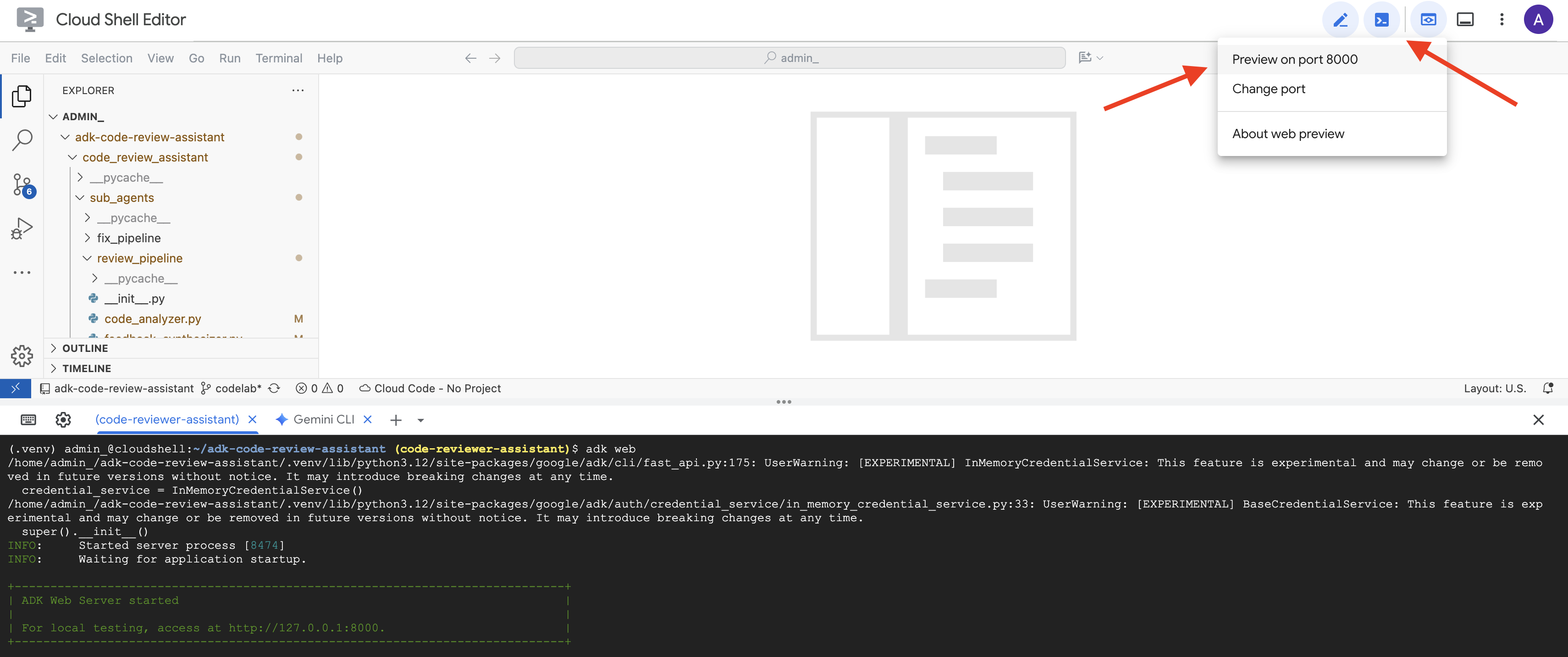
👉 代理程式現在正在執行。瀏覽器中的 ADK 開發人員使用者介面會直接連線至代理程式。
- 選取目標:在 UI 頂端的下拉式選單中,選擇
code_review_assistant代理程式。
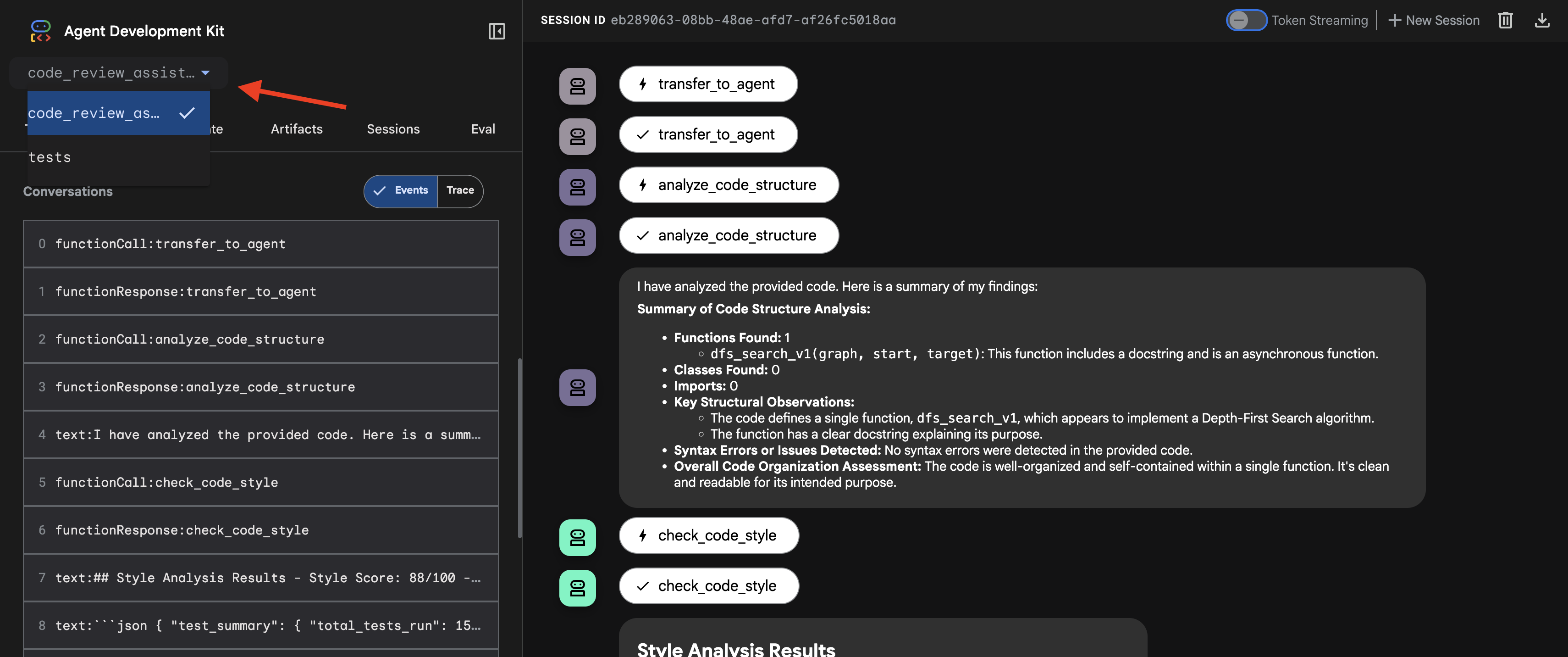
👉 測試提示:
Please analyze the following:
def dfs_search_v1(graph, start, target):
"""Find if target is reachable from start."""
visited = set()
stack = start
while stack:
current = stack.pop()
if current == target:
return True
if current not in visited:
visited.add(current)
for neighbor in graph[current]:
if neighbor not in visited:
stack.append(neighbor)
return False
👉 查看程式碼審查管道的實際運作情形:
提交有錯誤的 dfs_search_v1 函式時,您不只會收到一個答案,您正在見證多代理管道的運作。你看到的串流輸出內容,是四個專用代理程式依序執行的結果,每個代理程式都會以前一個代理程式的結果為基礎。
以下是各項代理程式對最終全面審查的貢獻,可將原始資料轉化為可做為行動依據的情報。
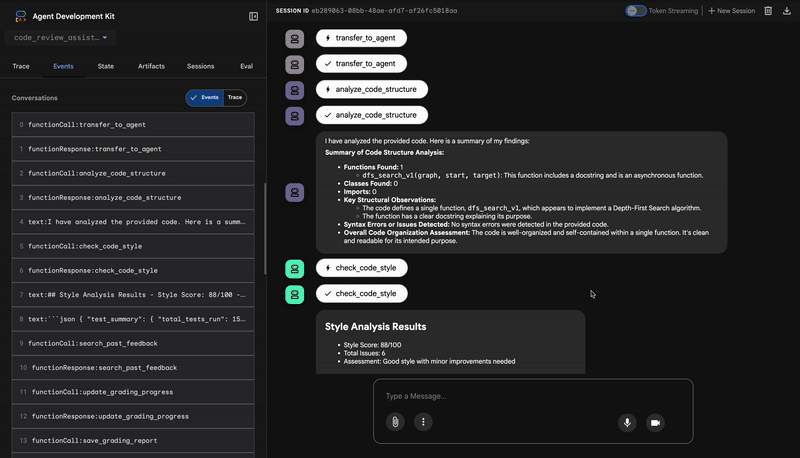
1. 程式碼分析器的結構報表
首先,CodeAnalyzer 代理程式會收到原始程式碼。不會猜測程式碼的作用,而是使用 analyze_code_structure 工具執行確定性的抽象語法樹 (AST) 剖析。
輸出內容是關於程式碼結構的純粹事實資料:
The analysis of the provided code reveals the following:
Summary:
- Functions Found: 1
- Classes Found: 0
Key Structural Observations:
- A single function, dfs_search_v1, is defined.
- It includes a docstring: "Find if target is reachable from start."
- No syntax errors were detected.
Overall Code Organization Assessment:
- The code snippet is a well-defined, self-contained function.
⭐ 價值:這個初始步驟可為其他代理程式提供乾淨可靠的基礎。確認程式碼是否為有效的 Python 程式碼,並找出需要檢查的確切元件。
2. Style Checker 的 PEP 8 稽核
接著,StyleChecker 代理程式會接手。這個工具會從共用狀態讀取程式碼,並使用 check_code_style 工具 (該工具會運用 pycodestyle 檢查工具)。
輸出結果為可量化的品質分數和具體違規事項:
Style Analysis Results
- Style Score: 88/100
- Total Issues: 6
- Assessment: Good style with minor improvements needed
Top Style Issues
- Line 5, W293: blank line contains whitespace
- Line 19, W292: no newline at end of file
⭐ 價值:這個代理程式會根據既定的社群標準 (PEP 8) 提供客觀且不容協商的回饋。加權評分系統會立即告知使用者問題的嚴重程度。
3. 測試執行工具發現的重大錯誤
這時系統會進行更深入的分析,TestRunner 代理程式會生成並執行一整套測試,驗證程式碼的行為。
輸出內容是結構化 JSON 物件,其中包含不利的判決:
{
"critical_issues": [
{
"type": "Critical Bug",
"description": "The function's initialization `stack = start` is incorrect... When a common input like a string... is provided... the function crashes with an AttributeError.",
"severity": "Critical"
}
],
"verdict": {
"status": "BROKEN",
"confidence": "high",
"recommendation": "The function is fundamentally broken... the stack initialization line `stack = start` must be changed to `stack = [start]`."
}
}
⭐ 價值:這是最重要的洞察資料。代理程式並非只是猜測,而是執行程式碼,證明程式碼已損毀。這項工具發現了細微但至關重要的執行階段錯誤,這類錯誤很容易被人工審查員忽略,並精確指出錯誤原因和必要修正措施。
4. 意見回饋綜合分析工具的最終報告
最後,FeedbackSynthesizer 代理程式會擔任指揮的角色,這項工具會從前三位服務專員的對話中擷取結構化資料,然後製作一份簡單易懂的報告,內容兼具分析性與鼓勵性。
最終輸出內容就是您看到的最終潤飾版評論:
📊 Summary
Great effort on implementing the Depth-First Search algorithm! ... However, a critical bug in the initialization of the stack prevents the function from working correctly...
✅ Strengths
- Good Algorithm Structure
- Correct Use of `visited` Set
📈 Code Quality Analysis
...
### Style Compliance
The style analysis returned a good score of 88/100.
...
### Test Results
The automated testing revealed a critical issue... The line `stack = start` directly assigns the input... which results in an `AttributeError`.
💡 Recommendations for Improvement
**Fix the Critical Stack Initialization Bug:**
- Incorrect Code: `stack = start`
- Correct Code: `stack = [start]`
💬 Encouragement
You are very close to a perfect implementation! The core logic of your DFS algorithm is sound, which is the hardest part.
⭐ 價值:這個智慧助理會將技術資料轉換為實用的教育體驗。這封郵件優先處理最重要的問題 (錯誤),清楚說明問題,提供確切的解決方案,並以鼓勵的語氣撰寫。並將先前各階段的發現整合為連貫且有價值的整體。
這個多階段程序展現了代理管道的強大功能。您會收到分層分析結果,而不是單一的整體回覆,因為每個代理程式都會執行可驗證的專業工作。這項做法不僅能提供深入的審查結果,還能確保結果具有確定性、可靠性及教育意義。
👉💻 測試完成後,請返回 Cloud Shell 編輯器終端機,然後按 Ctrl+C 停止 ADK 開發使用者介面。
建構項目
您現在擁有完整的程式碼審查管道,可執行下列作業:
✅ 剖析程式碼結構 - 使用輔助函式進行確定性 AST 分析
✅ 檢查樣式 - 使用命名慣例進行加權評分
✅ 執行測試 - 產生全面性測試,並以結構化 JSON 格式輸出
✅ 綜合回饋 - 整合狀態 + 記憶體 + 構件
✅ 追蹤進度 - 跨呼叫/工作階段/使用者的多層狀態
✅ 隨著時間學習 - 跨工作階段模式的記憶體服務
✅ 提供構件 - 可下載的 JSON 報表,內含完整稽核追蹤記錄
掌握基本概念
依序執行管道:
- 四個代理程式依嚴格順序執行
- 每個狀態都會豐富下一個狀態
- 依附元件會決定執行順序
生產模式:
- 輔助函式分離 (在執行緒集區中同步)
- 優雅降級 (備援策略)
- 多層級狀態管理 (暫時/工作階段/使用者)
- 動態指令提供者 (情境感知)
- 雙重儲存空間 (構件 + 狀態備援)
溝通狀態:
- 常數可避免代理程式發生錯別字
output_key將代理程式摘要寫入狀態- 稍後代理程式會透過 StateKeys 讀取
- 狀態會以線性方式流經管道
記憶體與狀態:
- 狀態:目前的工作階段資料
- 記憶:跨工作階段的模式
- 不同用途,不同生命週期
工具自動化調度管理:
- 單一工具代理程式 (分析器、樣式檢查器)
- 內建執行器 (test_runner)
- 多項工具協調 (合成器)
模型選取策略:
- 工作人員模型:機械工作 (剖析、檢查、路徑)
- 評論家模型:推理工作 (測試、綜合)
- 透過適當的選取項目最佳化成本
後續步驟
在單元 6 中,您將建構修正管道:
- LoopAgent 架構,可反覆修正
- 退出條件 (透過提升作業)
- 狀態累積 (跨疊代)
- 驗證和重試邏輯
- 整合審查管道,提供修正建議
您將瞭解如何將相同的狀態模式擴展至複雜的疊代工作流程 (代理程式會嘗試多次,直到成功為止),以及如何在單一應用程式中協調多個管道。
6. 新增修正管道:迴圈架構
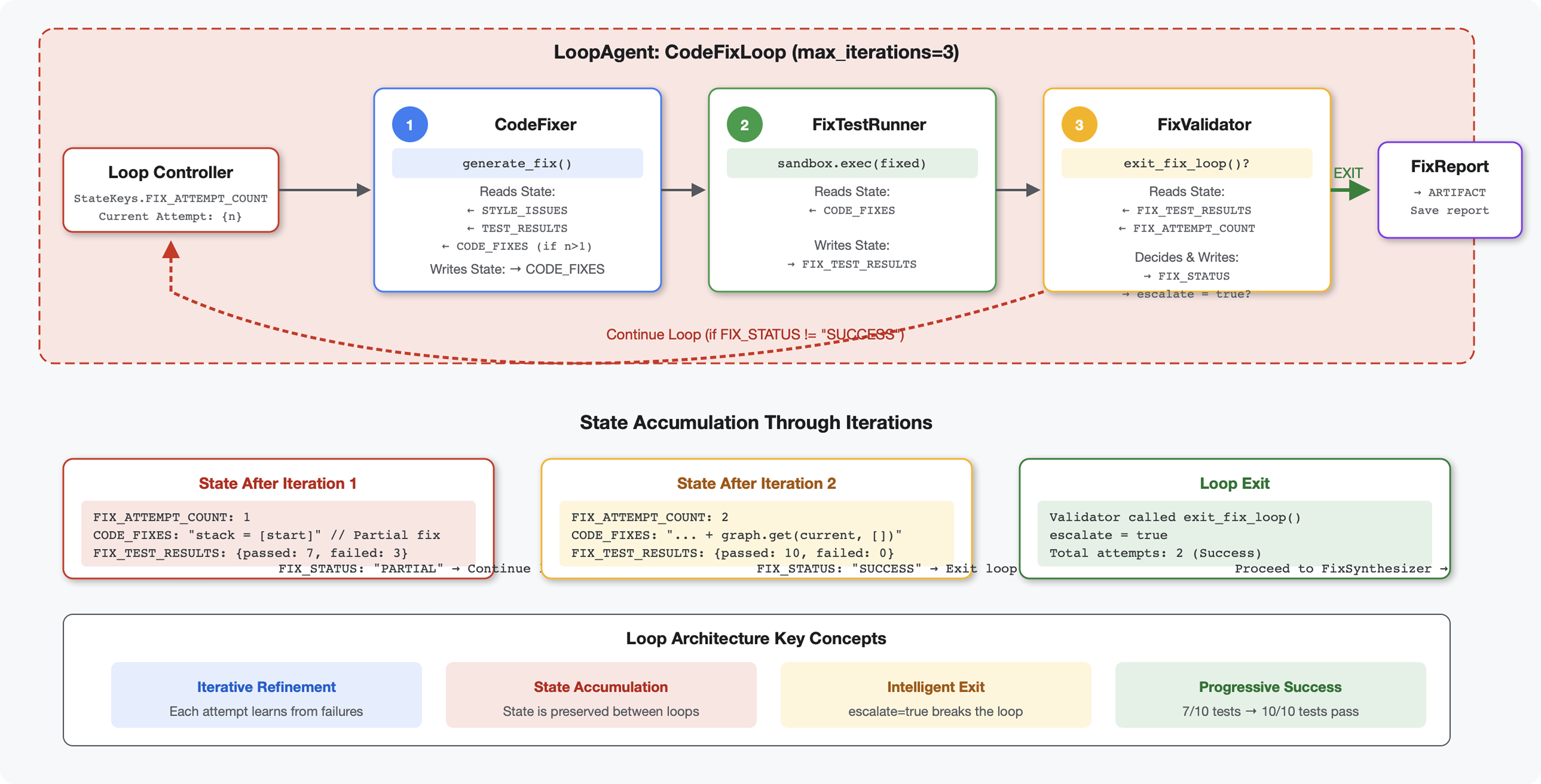
簡介
在第 5 模組中,您建構了循序審查管道,可分析程式碼並提供意見回饋。但找出問題只是解決方案的一半,開發人員還需要協助修正問題。
本單元會建構自動修正管道,可執行下列操作:
- 根據審查結果生成修正內容
- 透過執行全面測試來驗證修正結果
- 如果修正方式無效,系統會自動重試 (最多 3 次)
- 報表結果 (比較前後數據)
重要概念:LoopAgent 可自動重試。與只會執行一次的序列代理程式不同,LoopAgent 會重複執行子代理程式,直到符合結束條件或達到疊代次數上限為止。工具會設定 tool_context.actions.escalate = True,表示成功。
建構內容的預覽畫面:提交有錯誤的程式碼 → 檢查找出問題 → 修正迴圈產生修正內容 → 測試驗證 → 視需要重試 → 最終的完整報表。
核心概念:LoopAgent 與循序
循序管道 (第 5 單元):
SequentialAgent(agents=[A, B, C])
# Executes: A → B → C → Done
- 單向流程
- 每個代理程式只會執行一次
- 不重試邏輯
迴圈管道 (單元 6):
LoopAgent(agents=[A, B, C], max_iterations=3)
# Executes: A → B → C → (check exit) → A → B → C → (check exit) → ...
- 循環流程
- 代理程式可以多次執行
- 退出條件:
- 工具會設定
tool_context.actions.escalate = True(成功) - 已達
max_iterations(安全限制) - 發生未處理的例外狀況 (錯誤)
- 工具會設定
為什麼要使用迴圈修正程式碼:
通常需要多次嘗試才能修正程式碼:
- 第一次嘗試:修正明顯的錯誤 (變數類型錯誤)
- 第二次嘗試:修正測試發現的次要問題 (極端情況)
- 第三次嘗試:微調並驗證所有測試是否通過
如果沒有迴圈,您就需要在代理程式指令中加入複雜的條件邏輯。使用 LoopAgent 時,系統會自動重試。
架構比較:
Sequential (Module 5):
User → Review Pipeline → Feedback → Done
Loop (Module 6):
User → Review Pipeline → Feedback → Fix Pipeline
↓
┌──────────────┴──────────────┐
│ Fix Attempt Loop (1-3x) │
│ ┌─────────────────────┐ │
│ │ 1. Generate Fixes │ │
│ │ 2. Test Fixes │ │
│ │ 3. Validate & Exit? │────┼─→ If escalate=True
│ └─────────────────────┘ │ exit loop
│ ↓ If not │
│ Try Again (max 3) │
└─────────────────────────────┘
↓
4. Synthesize Final Report → Done
步驟 1:新增程式碼修正代理程式
程式碼修正工具會根據審查結果生成修正後的 Python 程式碼。
👉 開啟
code_review_assistant/sub_agents/fix_pipeline/code_fixer.py
👉 尋找:
# MODULE_6_STEP_1_CODE_FIXER_INSTRUCTION_PROVIDER
👉 將該單行程式碼替換為:
async def code_fixer_instruction_provider(context: ReadonlyContext) -> str:
"""Dynamic instruction provider that injects state variables."""
template = """You are an expert code fixing specialist.
Original Code:
{code_to_review}
Analysis Results:
- Style Score: {style_score}/100
- Style Issues: {style_issues}
- Test Results: {test_execution_summary}
Based on the test results, identify and fix ALL issues including:
- Interface bugs (e.g., if start parameter expects wrong type)
- Logic errors (e.g., KeyError when accessing graph nodes)
- Style violations
- Missing documentation
YOUR TASK:
Generate the complete fixed Python code that addresses all identified issues.
CRITICAL INSTRUCTIONS:
- Output ONLY the corrected Python code
- Do NOT include markdown code blocks (```python)
- Do NOT include any explanations or commentary
- The output should be valid, executable Python code and nothing else
Common fixes to apply based on test results:
- If tests show AttributeError with 'pop', fix: stack = [start] instead of stack = start
- If tests show KeyError accessing graph, fix: use graph.get(current, [])
- Add docstrings if missing
- Fix any style violations identified
Output the complete fixed code now:"""
return await instructions_utils.inject_session_state(template, context)
👉 尋找:
# MODULE_6_STEP_1_CODE_FIXER_AGENT
👉 將該單行程式碼替換為:
code_fixer_agent = Agent(
name="CodeFixer",
model=config.worker_model,
description="Generates comprehensive fixes for all identified code issues",
instruction=code_fixer_instruction_provider,
code_executor=BuiltInCodeExecutor(),
output_key="code_fixes"
)
步驟 2:新增修正測試執行器代理程式
修正測試執行器會對修正後的程式碼執行全面測試,驗證修正內容。
👉 開啟
code_review_assistant/sub_agents/fix_pipeline/fix_test_runner.py
👉 尋找:
# MODULE_6_STEP_2_FIX_TEST_RUNNER_INSTRUCTION_PROVIDER
👉 將該單行程式碼替換為:
async def fix_test_runner_instruction_provider(context: ReadonlyContext) -> str:
"""Dynamic instruction provider that uses the clean code from the previous step."""
template = """You are responsible for validating the fixed code by running tests.
THE FIXED CODE TO TEST:
{code_fixes}
ORIGINAL TEST RESULTS: {test_execution_summary}
YOUR TASK:
1. Understand the fixes that were applied
2. Generate the same comprehensive tests (15-20 test cases)
3. Execute the tests on the FIXED code using your code executor
4. Compare results with original test results
5. Output a detailed JSON analysis
TESTING METHODOLOGY:
- Run the same tests that revealed issues in the original code
- Verify that previously failing tests now pass
- Ensure no regressions were introduced
- Document the improvement
Execute your tests and output ONLY valid JSON with this structure:
- "passed": number of tests that passed
- "failed": number of tests that failed
- "total": total number of tests
- "pass_rate": percentage as a number
- "comparison": object with "original_pass_rate", "new_pass_rate", "improvement"
- "newly_passing_tests": array of test names that now pass
- "still_failing_tests": array of test names still failing
Do NOT output the test code itself, only the JSON analysis."""
return await instructions_utils.inject_session_state(template, context)
👉 尋找:
# MODULE_6_STEP_2_FIX_TEST_RUNNER_AGENT
👉 將該單行程式碼替換為:
fix_test_runner_agent = Agent(
name="FixTestRunner",
model=config.critic_model,
description="Runs comprehensive tests on fixed code to verify all issues are resolved",
instruction=fix_test_runner_instruction_provider,
code_executor=BuiltInCodeExecutor(),
output_key="fix_test_execution_summary"
)
步驟 3:新增修正驗證器代理程式
驗證器會檢查修正是否成功,並決定是否要結束迴圈。
瞭解工具
首先,請新增驗證器所需的三項工具。
👉 開啟
code_review_assistant/tools.py
👉 尋找:
# MODULE_6_STEP_3_VALIDATE_FIXED_STYLE
👉 Replace with Tool 1 - Style Validator:
async def validate_fixed_style(tool_context: ToolContext) -> Dict[str, Any]:
"""
Validates style compliance of the fixed code.
Args:
tool_context: ADK tool context containing fixed code in state
Returns:
Dictionary with style validation results
"""
logger.info("Tool: Validating style of fixed code...")
try:
# Get the fixed code from state
code_fixes = tool_context.state.get(StateKeys.CODE_FIXES, '')
# Try to extract from markdown if present
if '```python' in code_fixes:
start = code_fixes.rfind('```python') + 9
end = code_fixes.rfind('```')
if start < end:
code_fixes = code_fixes[start:end].strip()
if not code_fixes:
return {
"status": "error",
"message": "No fixed code found in state"
}
# Store the extracted fixed code
tool_context.state[StateKeys.CODE_FIXES] = code_fixes
# Run style check on fixed code
loop = asyncio.get_event_loop()
with ThreadPoolExecutor() as executor:
style_result = await loop.run_in_executor(
executor, _perform_style_check, code_fixes
)
# Compare with original
original_score = tool_context.state.get(StateKeys.STYLE_SCORE, 0)
improvement = style_result['score'] - original_score
# Store results
tool_context.state[StateKeys.FIXED_STYLE_SCORE] = style_result['score']
tool_context.state[StateKeys.FIXED_STYLE_ISSUES] = style_result['issues']
logger.info(f"Tool: Fixed code style score: {style_result['score']}/100 "
f"(improvement: +{improvement})")
return {
"status": "success",
"fixed_style_score": style_result['score'],
"original_style_score": original_score,
"improvement": improvement,
"remaining_issues": style_result['issues'],
"perfect_style": style_result['score'] == 100
}
except Exception as e:
logger.error(f"Tool: Style validation failed: {e}", exc_info=True)
return {
"status": "error",
"message": str(e)
}
👉 尋找:
# MODULE_6_STEP_3_COMPILE_FIX_REPORT
👉 改用工具 2 - 報表編譯器:
async def compile_fix_report(tool_context: ToolContext) -> Dict[str, Any]:
"""
Compiles comprehensive report of the fix process.
Args:
tool_context: ADK tool context with all fix pipeline data
Returns:
Comprehensive fix report
"""
logger.info("Tool: Compiling comprehensive fix report...")
try:
# Gather all data
original_code = tool_context.state.get(StateKeys.CODE_TO_REVIEW, '')
code_fixes = tool_context.state.get(StateKeys.CODE_FIXES, '')
# Test results
original_tests = tool_context.state.get(StateKeys.TEST_EXECUTION_SUMMARY, {})
fixed_tests = tool_context.state.get(StateKeys.FIX_TEST_EXECUTION_SUMMARY, {})
# Parse if strings
if isinstance(original_tests, str):
try:
original_tests = json.loads(original_tests)
except:
original_tests = {}
if isinstance(fixed_tests, str):
try:
fixed_tests = json.loads(fixed_tests)
except:
fixed_tests = {}
# Extract pass rates
original_pass_rate = 0
if original_tests:
if 'pass_rate' in original_tests:
original_pass_rate = original_tests['pass_rate']
elif 'test_summary' in original_tests:
# Handle test_runner_agent's JSON structure
summary = original_tests['test_summary']
total = summary.get('total_tests_run', 0)
passed = summary.get('tests_passed', 0)
if total > 0:
original_pass_rate = (passed / total) * 100
elif 'passed' in original_tests and 'total' in original_tests:
if original_tests['total'] > 0:
original_pass_rate = (original_tests['passed'] / original_tests['total']) * 100
fixed_pass_rate = 0
all_tests_pass = False
if fixed_tests:
if 'pass_rate' in fixed_tests:
fixed_pass_rate = fixed_tests['pass_rate']
all_tests_pass = fixed_tests.get('failed', 1) == 0
elif 'passed' in fixed_tests and 'total' in fixed_tests:
if fixed_tests['total'] > 0:
fixed_pass_rate = (fixed_tests['passed'] / fixed_tests['total']) * 100
all_tests_pass = fixed_tests.get('failed', 0) == 0
# Style scores
original_style = tool_context.state.get(StateKeys.STYLE_SCORE, 0)
fixed_style = tool_context.state.get(StateKeys.FIXED_STYLE_SCORE, 0)
# Calculate improvements
test_improvement = {
'original_pass_rate': original_pass_rate,
'fixed_pass_rate': fixed_pass_rate,
'improvement': fixed_pass_rate - original_pass_rate,
'all_tests_pass': all_tests_pass
}
style_improvement = {
'original_score': original_style,
'fixed_score': fixed_style,
'improvement': fixed_style - original_style,
'perfect_style': fixed_style == 100
}
# Determine overall status
if all_tests_pass and style_improvement['perfect_style']:
fix_status = 'SUCCESSFUL'
status_emoji = '✅'
elif test_improvement['improvement'] > 0 or style_improvement['improvement'] > 0:
fix_status = 'PARTIAL'
status_emoji = '⚠️'
else:
fix_status = 'FAILED'
status_emoji = '❌'
# Build comprehensive report
report = {
'status': fix_status,
'status_emoji': status_emoji,
'timestamp': datetime.now().isoformat(),
'original_code': original_code,
'code_fixes': code_fixes,
'improvements': {
'tests': test_improvement,
'style': style_improvement
},
'summary': f"{status_emoji} Fix Status: {fix_status}\n"
f"Tests: {original_pass_rate:.1f}% → {fixed_pass_rate:.1f}%\n"
f"Style: {original_style}/100 → {fixed_style}/100"
}
# Store report in state
tool_context.state[StateKeys.FIX_REPORT] = report
tool_context.state[StateKeys.FIX_STATUS] = fix_status
logger.info(f"Tool: Fix report compiled - Status: {fix_status}")
logger.info(f"Tool: Test improvement: {original_pass_rate:.1f}% → {fixed_pass_rate:.1f}%")
logger.info(f"Tool: Style improvement: {original_style} → {fixed_style}")
return {
"status": "success",
"fix_status": fix_status,
"report": report
}
except Exception as e:
logger.error(f"Tool: Failed to compile fix report: {e}", exc_info=True)
return {
"status": "error",
"message": str(e)
}
👉 尋找:
# MODULE_6_STEP_3_EXIT_FIX_LOOP
👉 以工具 3 取代 - 迴圈結束信號:
def exit_fix_loop(tool_context: ToolContext) -> Dict[str, Any]:
"""
Signal that fixing is complete and should exit the loop.
Args:
tool_context: ADK tool context
Returns:
Confirmation message
"""
logger.info("Tool: Setting escalate flag to exit fix loop")
# This is the critical line that exits the LoopAgent
tool_context.actions.escalate = True
return {
"status": "success",
"message": "Fix complete, exiting loop"
}
建立驗證器代理程式
👉 開啟
code_review_assistant/sub_agents/fix_pipeline/fix_validator.py
👉 尋找:
# MODULE_6_STEP_3_FIX_VALIDATOR_INSTRUCTION_PROVIDER
👉 將該單行程式碼替換為:
async def fix_validator_instruction_provider(context: ReadonlyContext) -> str:
"""Dynamic instruction provider that injects state variables."""
template = """You are the final validation specialist for code fixes.
You have access to:
- Original issues from initial review
- Applied fixes: {code_fixes}
- Test results after fix: {fix_test_execution_summary}
- All state data from the fix process
Your responsibilities:
1. Use validate_fixed_style tool to check style compliance of fixed code
- Pass no arguments, it will retrieve fixed code from state
2. Use compile_fix_report tool to generate comprehensive report
- Pass no arguments, it will gather all data from state
3. Based on the report, determine overall fix status:
- ✅ SUCCESSFUL: All tests pass, style score 100
- ⚠️ PARTIAL: Improvements made but issues remain
- ❌ FAILED: Fix didn't work or made things worse
4. CRITICAL: If status is SUCCESSFUL, call the exit_fix_loop tool to stop iterations
- This prevents unnecessary additional fix attempts
- If not successful, the loop will continue for another attempt
5. Provide clear summary of:
- What was fixed
- What improvements were achieved
- Any remaining issues requiring manual attention
Be precise and quantitative in your assessment.
"""
return await instructions_utils.inject_session_state(template, context)
👉 尋找:
# MODULE_6_STEP_3_FIX_VALIDATOR_AGENT
👉 將該單行程式碼替換為:
fix_validator_agent = Agent(
name="FixValidator",
model=config.worker_model,
description="Validates fixes and generates final fix report",
instruction=fix_validator_instruction_provider,
tools=[
FunctionTool(func=validate_fixed_style),
FunctionTool(func=compile_fix_report),
FunctionTool(func=exit_fix_loop)
],
output_key="final_fix_report"
)
步驟 4:瞭解 LoopAgent 結束條件
LoopAgent 有三種結束方式:
1. 成功結案 (透過升級)
# Inside any tool in the loop:
tool_context.actions.escalate = True
# Effect: Loop completes current iteration, then exits
# Use when: Fix is successful and no more attempts needed
範例流程:
Iteration 1:
CodeFixer → generates fixes
FixTestRunner → tests show 90% pass rate
FixValidator → compiles report, sees PARTIAL status
→ Does NOT set escalate
→ Loop continues
Iteration 2:
CodeFixer → refines fixes based on failures
FixTestRunner → tests show 100% pass rate
FixValidator → compiles report, sees SUCCESSFUL status
→ Calls exit_fix_loop() which sets escalate = True
→ Loop exits after this iteration
2. Max Iterations Exit
LoopAgent(
name="FixAttemptLoop",
sub_agents=[...],
max_iterations=3 # Safety limit
)
# Effect: After 3 complete iterations, loop exits regardless of escalate
# Use when: Prevent infinite loops if fixes never succeed
範例流程:
Iteration 1: PARTIAL (continue)
Iteration 2: PARTIAL (continue)
Iteration 3: PARTIAL (but max reached)
→ Loop exits, synthesizer presents best attempt
3. 錯誤結束
# If any agent throws unhandled exception:
raise Exception("Unexpected error")
# Effect: Loop exits immediately with error state
# Use when: Critical failure that can't be recovered
各次疊代中的狀態演變:
每次疊代都會更新前次嘗試的狀態:
# Before Iteration 1:
state = {
"code_to_review": "def add(a,b):return a+b", # Original
"style_score": 40,
"test_execution_summary": {...}
}
# After Iteration 1:
state = {
"code_to_review": "def add(a,b):return a+b", # Unchanged
"code_fixes": "def add(a, b):\n return a + b", # NEW
"style_score": 40, # Unchanged
"fixed_style_score": 100, # NEW
"test_execution_summary": {...}, # Unchanged
"fix_test_execution_summary": {...} # NEW
}
# Iteration 2 starts with all this state
# If fixes still not perfect, code_fixes gets overwritten
建議原因
escalate
取代傳回值:
# Bad: Using return value to signal exit
def validator_agent():
report = compile_report()
if report['status'] == 'SUCCESSFUL':
return {"exit": True} # How does loop know?
# Good: Using escalate
def validator_tool(tool_context):
report = compile_report()
if report['status'] == 'SUCCESSFUL':
tool_context.actions.escalate = True # Loop knows immediately
return {"report": report}
優點:
- 適用於任何工具,不限於最後使用的工具
- 不會干擾回傳資料
- 清楚的語意
- 架構會處理結束邏輯
步驟 5:連結修正管道
👉 開啟
code_review_assistant/agent.py
👉 新增修正管道匯入作業 (在現有匯入作業之後):
from google.adk.agents import LoopAgent # Add this to the existing Agent, SequentialAgent line
from code_review_assistant.sub_agents.fix_pipeline.code_fixer import code_fixer_agent
from code_review_assistant.sub_agents.fix_pipeline.fix_test_runner import fix_test_runner_agent
from code_review_assistant.sub_agents.fix_pipeline.fix_validator import fix_validator_agent
from code_review_assistant.sub_agents.fix_pipeline.fix_synthesizer import fix_synthesizer_agent
匯入內容現在應如下所示:
from google.adk.agents import Agent, SequentialAgent, LoopAgent
from .config import config
# Review pipeline imports (from Module 5)
from code_review_assistant.sub_agents.review_pipeline.code_analyzer import code_analyzer_agent
from code_review_assistant.sub_agents.review_pipeline.style_checker import style_checker_agent
from code_review_assistant.sub_agents.review_pipeline.test_runner import test_runner_agent
from code_review_assistant.sub_agents.review_pipeline.feedback_synthesizer import feedback_synthesizer_agent
# Fix pipeline imports (NEW)
from code_review_assistant.sub_agents.fix_pipeline.code_fixer import code_fixer_agent
from code_review_assistant.sub_agents.fix_pipeline.fix_test_runner import fix_test_runner_agent
from code_review_assistant.sub_agents.fix_pipeline.fix_validator import fix_validator_agent
from code_review_assistant.sub_agents.fix_pipeline.fix_synthesizer import fix_synthesizer_agent
👉 尋找:
# MODULE_6_STEP_5_CREATE_FIX_LOOP
👉 將該單行程式碼替換為:
# Create the fix attempt loop (retries up to 3 times)
fix_attempt_loop = LoopAgent(
name="FixAttemptLoop",
sub_agents=[
code_fixer_agent, # Step 1: Generate fixes
fix_test_runner_agent, # Step 2: Validate with tests
fix_validator_agent # Step 3: Check success & possibly exit
],
max_iterations=3 # Try up to 3 times
)
# Wrap loop with synthesizer for final report
code_fix_pipeline = SequentialAgent(
name="CodeFixPipeline",
description="Automated code fixing pipeline with iterative validation",
sub_agents=[
fix_attempt_loop, # Try to fix (1-3 times)
fix_synthesizer_agent # Present final results (always runs once)
]
)
👉 移除現有
root_agent
定義:
root_agent = Agent(...)
👉 尋找:
# MODULE_6_STEP_5_UPDATE_ROOT_AGENT
👉 將該單行程式碼替換為:
# Update root agent to include both pipelines
root_agent = Agent(
name="CodeReviewAssistant",
model=config.worker_model,
description="An intelligent code review assistant that analyzes Python code and provides educational feedback",
instruction="""You are a specialized Python code review assistant focused on helping developers improve their code quality.
When a user provides Python code for review:
1. Immediately delegate to CodeReviewPipeline and pass the code EXACTLY as it was provided by the user.
2. The pipeline will handle all analysis and feedback
3. Return ONLY the final feedback from the pipeline - do not add any commentary
After completing a review, if significant issues were identified:
- If style score < 100 OR tests are failing OR critical issues exist:
* Add at the end: "\n\n💡 I can fix these issues for you. Would you like me to do that?"
- If the user responds yes or requests fixes:
* Delegate to CodeFixPipeline
* Return the fix pipeline's complete output AS-IS
When a user asks what you can do or general questions:
- Explain your capabilities for code review and fixing
- Do NOT trigger the pipeline for non-code messages
The pipelines handle everything for code review and fixing - just pass through their final output.""",
sub_agents=[code_review_pipeline, code_fix_pipeline],
output_key="assistant_response"
)
步驟 6:新增 Fix Synthesizer Agent
迴圈完成後,合成器會以簡單易懂的方式呈現修正結果。
👉 開啟
code_review_assistant/sub_agents/fix_pipeline/fix_synthesizer.py
👉 尋找:
# MODULE_6_STEP_6_FIX_SYNTHESIZER_INSTRUCTION_PROVIDER
👉 將該單行程式碼替換為:
async def fix_synthesizer_instruction_provider(context: ReadonlyContext) -> str:
"""Dynamic instruction provider that injects state variables."""
template = """You are responsible for presenting the fix results to the user.
Based on the validation report: {final_fix_report}
Fixed code from state: {code_fixes}
Fix status: {fix_status}
Create a comprehensive yet friendly response that includes:
## 🔧 Fix Summary
[Overall status and key improvements - be specific about what was achieved]
## 📊 Metrics
- Test Results: [original pass rate]% → [new pass rate]%
- Style Score: [original]/100 → [new]/100
- Issues Fixed: X of Y
## ✅ What Was Fixed
[List each fixed issue with brief explanation of the correction made]
## 📝 Complete Fixed Code
[Include the complete, corrected code from state - this is critical]
## 💡 Explanation of Key Changes
[Brief explanation of the most important changes made and why]
[If any issues remain]
## ⚠️ Remaining Issues
[List what still needs manual attention]
## 🎯 Next Steps
[Guidance on what to do next - either use the fixed code or address remaining issues]
Save the fix report using save_fix_report tool before presenting.
Call it with no parameters - it will retrieve the report from state automatically.
Be encouraging about improvements while being honest about any remaining issues.
Focus on the educational aspect - help the user understand what was wrong and how it was fixed.
"""
return await instructions_utils.inject_session_state(template, context)
👉 尋找:
# MODULE_6_STEP_6_FIX_SYNTHESIZER_AGENT
👉 將該單行程式碼替換為:
fix_synthesizer_agent = Agent(
name="FixSynthesizer",
model=config.critic_model,
description="Creates comprehensive user-friendly fix report",
instruction=fix_synthesizer_instruction_provider,
tools=[FunctionTool(func=save_fix_report)],
output_key="fix_summary"
)
👉 新增
save_fix_report
工具
tools.py
:
👉 尋找:
# MODULE_6_STEP_6_SAVE_FIX_REPORT
👉 替換為:
async def save_fix_report(tool_context: ToolContext) -> Dict[str, Any]:
"""
Saves the fix report as an artifact.
Args:
tool_context: ADK tool context
Returns:
Save status
"""
logger.info("Tool: Saving fix report...")
try:
# Get the report from state
fix_report = tool_context.state.get(StateKeys.FIX_REPORT, {})
if not fix_report:
return {
"status": "error",
"message": "No fix report found in state"
}
# Convert to JSON
report_json = json.dumps(fix_report, indent=2)
report_part = types.Part.from_text(text=report_json)
# Generate filename
timestamp = datetime.now().isoformat().replace(':', '-')
filename = f"fix_report_{timestamp}.json"
# Try to save as artifact
if hasattr(tool_context, 'save_artifact'):
try:
version = await tool_context.save_artifact(filename, report_part)
await tool_context.save_artifact("latest_fix_report.json", report_part)
logger.info(f"Tool: Fix report saved as {filename}")
return {
"status": "success",
"filename": filename,
"version": str(version),
"size": len(report_json)
}
except Exception as e:
logger.warning(f"Could not save as artifact: {e}")
# Fallback: store in state
tool_context.state[StateKeys.LAST_FIX_REPORT] = fix_report
return {
"status": "success",
"message": "Fix report saved to state",
"size": len(report_json)
}
except Exception as e:
logger.error(f"Tool: Failed to save fix report: {e}", exc_info=True)
return {
"status": "error",
"message": str(e)
}
步驟 7:測試完整修正管道
現在來看看整個迴圈的實際運作方式。
👉 啟動系統:
adk web code_review_assistant
執行 adk web 指令後,終端機應會顯示 ADK Web Server 已啟動的輸出內容,類似如下:
+-----------------------------------------------------------------------------+
| ADK Web Server started |
| |
| For local testing, access at http://localhost:8000. |
+-----------------------------------------------------------------------------+
INFO: Application startup complete.
INFO: Uvicorn running on http://0.0.0.0:8000 (Press CTRL+C to quit)
👉 測試提示:
Please analyze the following:
def dfs_search_v1(graph, start, target):
"""Find if target is reachable from start."""
visited = set()
stack = start
while stack:
current = stack.pop()
if current == target:
return True
if current not in visited:
visited.add(current)
for neighbor in graph[current]:
if neighbor not in visited:
stack.append(neighbor)
return False
首先,請提交有錯誤的程式碼,觸發審查管道。找出瑕疵後,請要求代理程式「請修正程式碼」,這會觸發強大的疊代式修正管道。
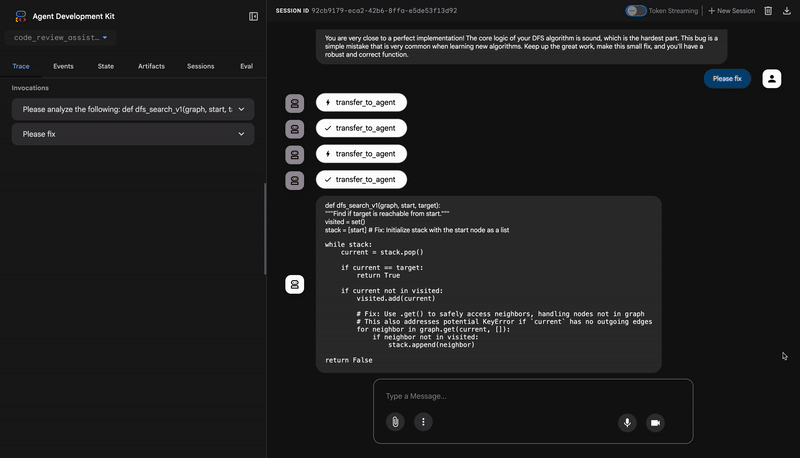
1. 初步審查 (找出安全漏洞)
這是程序的前半段。四個代理程式審查管道會分析程式碼、檢查樣式,並執行產生的測試套件。正確找出重大 AttributeError 和其他問題,並做出判斷:程式碼有問題,測試通過率僅 84.21%。
2. 自動修正 (迴圈運作)
這也是最令人驚豔的部分。請代理程式修正程式碼時,代理程式不會只進行一項變更,這會啟動疊代式「修正及驗證迴圈」,就像勤奮的開發人員一樣:嘗試修正、徹底測試,如果不完美,就再次嘗試。
疊代 #1:首次嘗試 (部分成功)
- 修正:
CodeFixer代理程式會讀取初始報告,並進行最明顯的修正。這會將stack = start變更為stack = [start],並使用graph.get()來避免KeyError例外狀況。 - 驗證:
TestRunner會立即對這個新代碼重新執行完整測試套件。 - 結果:及格率大幅提升至 88.89%!重大錯誤已修正。不過,這些測試非常全面,因此揭露了兩個新的細微錯誤 (迴歸),與處理
None做為圖表或非清單鄰項值有關。系統會將修正標示為「部分」。
第 2 次疊代:最後潤飾 (100% 成功)
- 修正方式:由於迴圈的結束條件 (100% 通過率) 未達成,因此會再次執行。
CodeFixer現在有更多資訊,包括兩項新的迴歸失敗。並產生最終的更健全程式碼版本,明確處理這些極端情況。 - 驗證:
TestRunner會針對最終版本的程式碼,最後一次執行測試套件。 - 結果:100% 通過率。所有原始錯誤和迴歸問題都已解決。系統會將修正作業標示為「成功」,並結束迴圈。
3. 最終報告:滿分
確認修正方式完全有效後,FixSynthesizer 專員會接手提供最終報告,將技術資料轉換為清楚易懂的摘要。
指標 | 之前 | 晚於 | 改善項目 |
測試通過率 | 84.21% | 100% | ▲ 15.79% |
風格分數 | 88 / 100 | 98 / 100 | ▲ 10 分 |
修正錯誤 | 0/3 | 3/3 | ✅ |
✅ 最終驗證碼
以下是修正後的完整程式碼,現在已通過所有 19 項測試,證明修正成功:
def dfs_search_v1(graph, start, target):
"""Find if target is reachable from start."""
# Handles 'None' graph input
if graph is None:
return False
visited = set()
# Fixes the critical AttributeError
stack = [start]
while stack:
current = stack.pop()
if current == target:
return True
if current not in visited:
visited.add(current)
# Safely gets neighbors to prevent KeyError
neighbors = graph.get(current)
if neighbors is None:
continue
# Validates that neighbors are iterable
if not isinstance(neighbors, (list, set, tuple)):
raise TypeError(
f"Graph value for node '{current}' is of type "
f"{type(neighbors).__name__}. Expected a list, set, or tuple."
)
for neighbor in neighbors:
if neighbor not in visited:
stack.append(neighbor)
return False
👉💻 測試完成後,請返回 Cloud Shell 編輯器終端機,然後按 Ctrl+C 停止 ADK 開發使用者介面。
建構項目
您現在擁有完整的自動修正管道,可執行下列作業:
✅ 生成修正內容 - 根據審查分析結果
✅ 反覆驗證 - 每次嘗試修正後都會進行測試
✅ 自動重試 - 最多嘗試 3 次,直到成功為止
✅ 智慧退出 - 成功時會透過升級退出
✅ 追蹤改善情形 - 比較修正前後的指標
✅ 提供構件 - 可下載的修正報告
掌握基本概念
LoopAgent 與循序:
- 循序:代理程式會依序執行
- LoopAgent:重複執行,直到達到結束條件或疊代次數上限
- 從
tool_context.actions.escalate = True出站
各次疊代中的狀態演變:
CODE_FIXES在每次疊代時更新- 測試結果顯示成效隨時間改善
- 驗證者會看到累計變更
多管道架構:
- 查看管道:唯讀分析 (單元 5)
- 修正迴圈:反覆修正 (第 6 模組內迴圈)
- 固定管線:迴路 + 合成器 (模組 6 外側)
- 根代理程式:根據使用者意圖協調
控制流程的工具:
exit_fix_loop()組- 任何工具都可以發出迴圈完成訊號
- 將結束邏輯與代理程式指令分離
最大疊代次數安全措施:
- 防止無限迴圈
- 確保系統一律會回應
- 即使不完美,也會盡力呈現最佳結果
後續步驟
在最後一個單元中,您將瞭解如何將代理程式部署至正式環境:
- 使用 VertexAiSessionService 設定永久儲存空間
- 部署至 Google Cloud 上的 Agent Engine
- 監控及偵錯正式環境代理程式
- 擴充和可靠性的最佳做法
您已使用循序和迴圈架構建構完整的多代理系統。您學到的模式 (狀態管理、動態指令、工具協調和疊代式精進) 都是實際代理程式系統中使用的技術,可直接用於正式環境。
7. 部署至正式環境
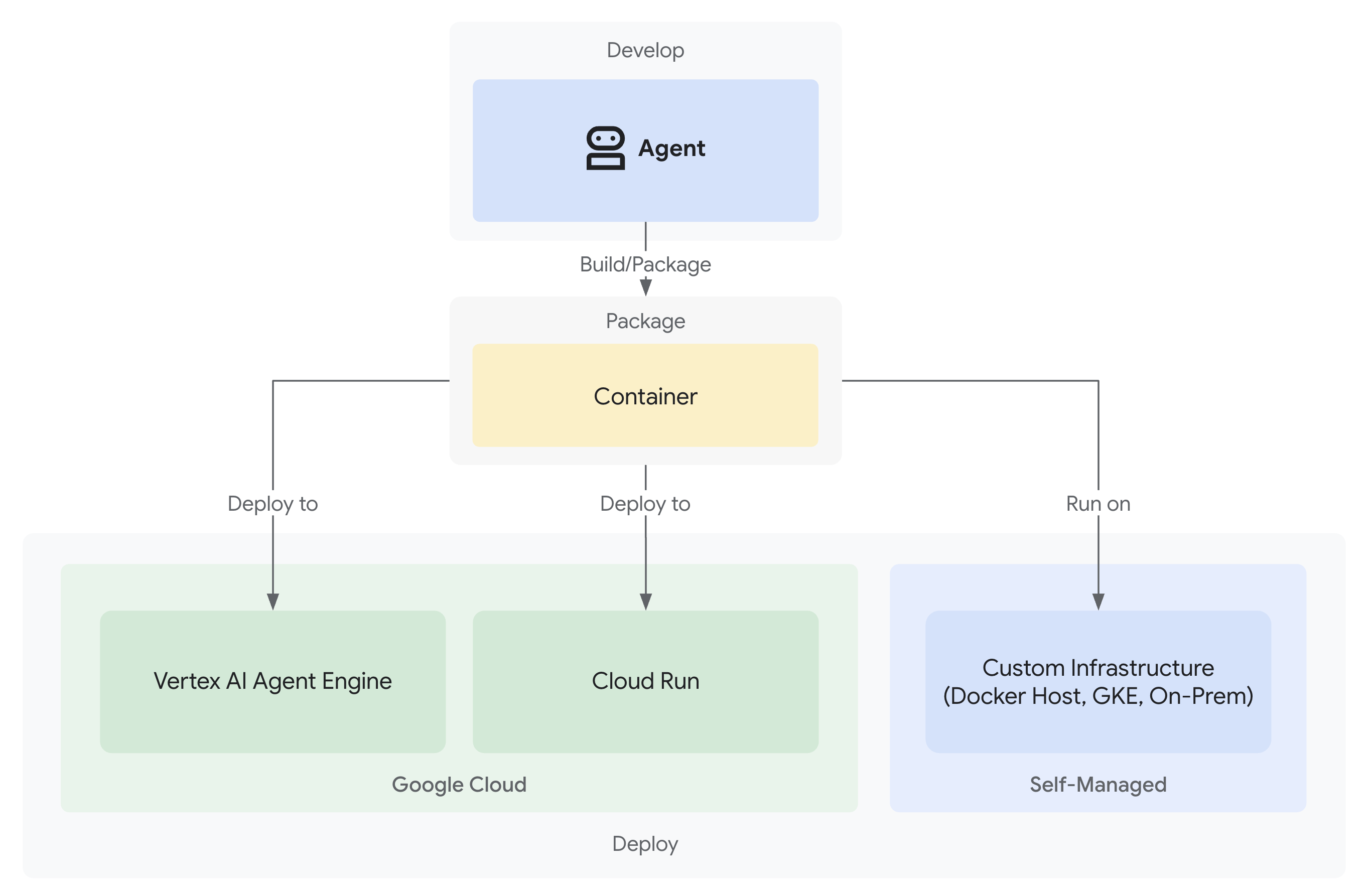
簡介
程式碼審查助理現在已完成,審查和修正管道可在本機運作。缺點:只能在您的電腦上執行。在本單元中,您將代理程式部署至 Google Cloud,讓團隊透過持續性工作階段和正式環境等級的基礎架構存取代理程式。
白皮書內容:
- 三種部署方式:本機、Cloud Run 和 Agent Engine
- 自動化基礎架構佈建
- 工作階段保留策略
- 測試已部署的代理程式
瞭解部署選項
ADK 支援多個部署目標,每個目標都有不同的取捨:
部署路徑
因素 | 當地 ( | Cloud Run ( | Agent Engine ( |
複雜度 | 最低 | 中 | 低 |
工作階段持續性 | 僅限記憶體內 (重新啟動後會遺失) | Cloud SQL (PostgreSQL) | Vertex AI 管理 (自動) |
基礎架構 | 無 (僅限開發機器) | 容器 + 資料庫 | 全代管 |
冷啟動 | 不適用 | 100 至 2000 毫秒 | 100 到 500 毫秒 |
擴大運用 | 單一執行個體 | 自動 (歸零) | 自動 |
費用模式 | 免費 (本機運算) | 以要求為依據 + 免費方案 | 以運算為準 |
UI 支援 | 是 (透過 | 是 (透過 | 否 (僅限 API) |
最適合用於 | 開發/測試 | 流量不穩定,需要控制成本 | 製作代理商 |
其他部署選項:Google Kubernetes Engine (GKE) 適用於需要 Kubernetes 層級控制、自訂網路或多服務協調作業的高階使用者。本程式碼研究室不會介紹 GKE 部署作業,但 ADK 部署指南中已提供相關說明。
部署內容
部署至 Cloud Run 或 Agent Engine 時,系統會封裝並部署下列項目:
- 您的代理程式碼 (
agent.py,所有子代理程式、工具) - 依附元件 (
requirements.txt) - ADK API 伺服器 (自動納入)
- 網頁介面 (僅限 Cloud Run,且必須指定
--with_ui)
重要差異:
- Cloud Run:使用
adk deploy cloud_runCLI (自動建構容器) 或gcloud run deploy(需要自訂 Dockerfile) - Agent Engine:使用
adk deploy agent_engineCLI (無須建構容器,直接封裝 Python 程式碼)
步驟 1:設定環境
設定 .env 檔案
您需要更新 .env 檔案 (在第 3 節中建立),才能進行雲端部署。開啟 .env,然後確認/更新下列設定:
所有雲端部署作業的必要步驟:
# Your actual GCP Project ID (REQUIRED)
GOOGLE_CLOUD_PROJECT=your-project-id
# GCP region for deployments (REQUIRED)
GOOGLE_CLOUD_LOCATION=us-central1
# Use Vertex AI (REQUIRED)
GOOGLE_GENAI_USE_VERTEXAI=true
# Model configuration (already set)
WORKER_MODEL=gemini-2.5-flash
CRITIC_MODEL=gemini-2.5-pro
設定 bucket 名稱 (執行 deploy.sh 前的必要步驟):
部署指令碼會根據這些名稱建立 bucket。立即設定:
# Staging bucket for Agent Engine code uploads (REQUIRED for agent-engine)
STAGING_BUCKET=gs://your-project-id-staging
# Artifact storage for reports and fixed code (REQUIRED for both cloud-run and agent-engine)
ARTIFACT_BUCKET=gs://your-project-id-artifacts
在兩個 bucket 名稱中,將 your-project-id 替換為實際專案 ID。如果這些值區不存在,指令碼會建立這些值區。
選用變數 (空白時會自動建立):
# Agent Engine ID (populated after first deployment)
AGENT_ENGINE_ID=
# Cloud Run Database credentials (created automatically if blank)
CLOUD_SQL_INSTANCE_NAME=
DB_USER=
DB_PASSWORD=
DB_NAME=
驗證檢查
如果在部署期間發生驗證錯誤:
gcloud auth application-default login
gcloud config set project $GOOGLE_CLOUD_PROJECT
步驟 2:瞭解部署指令碼
deploy.sh 指令碼為所有部署模式提供統一介面:
./deploy.sh {local|cloud-run|agent-engine}
指令碼功能
基礎架構佈建:
- 啟用 API (AI Platform、Storage、Cloud Build、Cloud Trace、Cloud SQL)
- IAM 權限設定 (服務帳戶、角色)
- 建立資源 (buckets、資料庫、執行個體)
- 使用適當的旗標進行部署
- 部署後驗證
指令碼主要部分
- 設定 (第 1 至 35 行):專案、區域、服務名稱、預設值
- 輔助函式 (第 37 至 200 行):啟用 API、建立 bucket、設定 IAM
- 主要邏輯 (第 202 至 400 行):模式專屬的部署自動化調度管理
步驟 3:準備 Agent Engine 的 Agent
部署至 Agent Engine 前,您需要 agent_engine_app.py 檔案,將代理程式包裝至受管理執行階段。系統已為您建立這項設定。
查看code_review_assistant/agent_engine_app.py
👉 開啟檔案:
"""
Agent Engine application wrapper.
This file prepares the agent for deployment to Vertex AI Agent Engine.
"""
from vertexai import agent_engines
from .agent import root_agent
# Wrap the agent in an AdkApp object for Agent Engine deployment
app = agent_engines.AdkApp(
agent=root_agent,
enable_tracing=True,
)
步驟 4:部署至 Agent Engine
Agent Engine 是 ADK 代理的建議正式環境部署方式,因為它提供:
- 全代管基礎架構 (不必建構容器)
- 透過
VertexAiSessionService內建工作階段持續性 - 從零開始自動調整資源配置
- 預設啟用 Cloud Trace 整合功能
Agent Engine 與其他部署方式的差異
幕後運作方式:
deploy.sh agent-engine
用途:
adk deploy agent_engine \
--project=$GOOGLE_CLOUD_PROJECT \
--region=$GOOGLE_CLOUD_LOCATION \
--staging_bucket=$STAGING_BUCKET \
--display_name="Code Review Assistant" \
--trace_to_cloud \
code_review_assistant
此指令會執行下列作業:
- 直接封裝 Python 程式碼 (不需 Docker 建構作業)
- 上傳至
.env中指定的暫存值區 - 建立代管的 Agent Engine 執行個體
- 啟用 Cloud Trace,以利觀測
- 使用
agent_engine_app.py設定執行階段
與會將程式碼容器化的 Cloud Run 不同,Agent Engine 會直接在受管理執行階段環境中執行 Python 程式碼,類似於無伺服器函式。
執行部署作業
從專案根目錄:
./deploy.sh agent-engine
部署階段
觀看指令碼執行下列階段:
Phase 1: API Enablement
✓ aiplatform.googleapis.com
✓ storage-api.googleapis.com
✓ cloudbuild.googleapis.com
✓ cloudtrace.googleapis.com
Phase 2: IAM Setup
✓ Getting project number
✓ Granting Storage Object Admin
✓ Granting AI Platform User
✓ Granting Cloud Trace Agent
Phase 3: Staging Bucket
✓ Creating gs://your-project-id-staging
✓ Setting permissions
Phase 4: Artifact Bucket
✓ Creating gs://your-project-id-artifacts
✓ Configuring access
Phase 5: Validation
✓ Checking agent.py exists
✓ Verifying root_agent defined
✓ Checking agent_engine_app.py exists
✓ Validating requirements.txt
Phase 6: Build & Deploy
✓ Packaging agent code
✓ Uploading to staging bucket
✓ Creating Agent Engine instance
✓ Configuring session persistence
✓ Setting up Cloud Trace integration
✓ Running health checks
這項程序需要 5 到 10 分鐘,因為系統會封裝代理程式並部署至 Vertex AI 基礎架構。
儲存 Agent Engine ID
部署成功後:
✅ Deployment successful!
Agent Engine ID: 7917477678498709504
Resource Name: projects/123456789/locations/us-central1/reasoningEngines/7917477678498709504
Endpoint: https://us-central1-aiplatform.googleapis.com/v1/...
⚠️ IMPORTANT: Save this in your .env file:
AGENT_ENGINE_ID=7917477678498709504
更新
.env
檔案:
echo "AGENT_ENGINE_ID=7917477678498709504" >> .env
您必須提供此 ID,才能:
- 測試已部署的代理程式
- 稍後更新部署作業
- 存取記錄和追蹤記錄
部署內容
Agent Engine 部署作業現在包含:
✅ 完整審查管道 (4 位專員)
✅ 完整修正管道 (迴圈 + 合成器)
✅ 所有工具 (AST 分析、樣式檢查、構件生成)
✅ 工作階段持續性 (透過 VertexAiSessionService 自動)
✅ 狀態管理 (工作階段/使用者/生命週期層級)
✅ 可觀測性 (已啟用 Cloud Trace)
✅ 自動調度資源程序基礎架構
步驟 5:測試已部署的代理程式
更新 .env 檔案
部署完成後,請確認 .env 包含:
AGENT_ENGINE_ID=7917477678498709504 # From deployment output
GOOGLE_CLOUD_PROJECT=your-project-id
GOOGLE_CLOUD_LOCATION=us-central1
執行測試指令碼
專案包含 tests/test_agent_engine.py,專門用於測試 Agent Engine 部署作業:
python tests/test_agent_engine.py
測試內容
- 驗證 Google Cloud 專案
- 建立工作階段,並使用已部署的代理程式
- 傳送程式碼審查要求 (DFS 錯誤範例)
- 透過伺服器推送事件 (SSE) 串流回應
- 驗證工作階段持續性和狀態管理
預期輸出
Authenticated with project: your-project-id
Targeting Agent Engine: projects/.../reasoningEngines/7917477678498709504
Creating new session...
Created session: 4857885913439920384
Sending query to agent and streaming response:
data: {"content": {"parts": [{"text": "I'll analyze your code..."}]}}
data: {"content": {"parts": [{"text": "**Code Structure Analysis**\n..."}]}}
data: {"content": {"parts": [{"text": "**Style Check Results**\n..."}]}}
data: {"content": {"parts": [{"text": "**Test Results**\n..."}]}}
data: {"content": {"parts": [{"text": "**Final Feedback**\n..."}]}}
Stream finished.
驗證檢查清單
- ✅ 執行完整審查管道 (所有 4 位專員)
- ✅ 串流回應會逐步顯示輸出內容
- ✅ 工作階段狀態會在要求之間保留
- ✅ 沒有驗證或連線錯誤
- ✅ 工具呼叫執行成功 (AST 分析、樣式檢查)
- ✅ 儲存構件 (可存取評分報告)
替代方案:部署至 Cloud Run
建議使用 Agent Engine 簡化正式環境部署作業,但 Cloud Run 提供更多控制選項,並支援 ADK 網頁使用者介面。本節提供總覽說明。
使用 Cloud Run 的時機
如果您需要下列功能,請選擇 Cloud Run:
- ADK 網頁 UI,供使用者互動
- 完整掌控容器環境
- 自訂資料庫設定
- 與現有 Cloud Run 服務整合
Cloud Run 部署作業的運作方式
幕後運作方式:
deploy.sh cloud-run
用途:
adk deploy cloud_run \
--project=$GOOGLE_CLOUD_PROJECT \
--region=$GOOGLE_CLOUD_LOCATION \
--service_name="code-review-assistant" \
--app_name="code_review_assistant" \
--port=8080 \
--with_ui \
--artifact_service_uri="gs://$ARTIFACT_BUCKET" \
--trace_to_cloud \
code_review_assistant
此指令會執行下列作業:
- 使用代理程式碼建構 Docker 容器
- 推送至 Google Artifact Registry
- 以 Cloud Run 服務的形式部署
- 包含 ADK 網頁版 UI (
--with_ui) - 設定 Cloud SQL 連線 (初始部署後由指令碼新增)
與 Agent Engine 的主要差異:Cloud Run 會將程式碼容器化,並需要資料庫來保存工作階段,而 Agent Engine 會自動處理這兩項作業。
Cloud Run 部署指令
./deploy.sh cloud-run
不同之處
基礎架構:
- 容器化部署 (Docker 由 ADK 自動建構)
- 使用 Cloud SQL (PostgreSQL) 持久儲存工作階段
- 指令碼自動建立的資料庫,或使用現有執行個體
工作階段管理:
- 使用
DatabaseSessionService,而非VertexAiSessionService - 需要
.env中的資料庫憑證 (或自動產生) - 狀態會保留在 PostgreSQL 資料庫中
UI 支援:
- 可透過
--with_ui旗標使用網頁 UI (由指令碼處理) - 存取位置:
https://code-review-assistant-xyz.a.run.app
你的成就
正式版部署作業包括:
✅ 透過 deploy.sh 指令碼
自動佈建 ✅ 代管基礎架構 (Agent Engine 會處理擴充、持續性、監控)
✅ 所有記憶體層級 (工作階段/使用者/生命週期) 的持續性狀態
✅ 安全憑證管理 (自動產生和 IAM 設定)
✅ 可擴充架構 (從零到數千名並行使用者)
✅ 內建可觀測性 (已啟用 Cloud Trace 整合)
✅ 正式版錯誤處理和復原
掌握基本概念
部署準備:
agent_engine_app.py:使用AdkApp包裝代理程式,以供 Agent Engine 使用AdkApp會自動設定VertexAiSessionService以確保資料持續存在- 已透過
enable_tracing=True啟用追蹤功能
部署指令:
adk deploy agent_engine:封裝 Python 程式碼,不含容器adk deploy cloud_run:自動建構 Docker 容器gcloud run deploy:使用自訂 Dockerfile 的替代做法
部署選項:
- Agent Engine:全代管,最快可部署至正式環境
- Cloud Run:提供更多控制權,支援網頁版 UI
- GKE:進階 Kubernetes 控制項 (請參閱 GKE 部署指南)
代管服務:
- Agent Engine 會自動處理工作階段持續性
- Cloud Run 需要設定資料庫 (或自動建立)
- 兩者都支援透過 GCS 儲存構件
工作階段管理:
- 代理引擎:
VertexAiSessionService(自動) - Cloud Run:
DatabaseSessionService(Cloud SQL) - 本機:
InMemorySessionService(暫時性)
服務專員已上線
程式碼審查助理現在是:
- 透過 HTTPS API 端點存取
- Persistent:狀態會在重新啟動後保留
- 可擴充,自動因應團隊成長
- 可觀察,並提供完整的要求追蹤記錄
- 透過指令碼部署作業維護
後續步驟 在第 8 個單元中,您將瞭解如何使用 Cloud Trace 掌握代理程式的效能、找出審查和修正管道中的瓶頸,以及縮短執行時間。
8. 正式版觀測能力

簡介
程式碼審查助理現已部署完畢,並在 Agent Engine 的實際工作環境中執行。但要怎麼知道工具是否正常運作呢?你能回答下列重要問題嗎?
- 服務專員的回覆速度是否夠快?
- 哪些作業最慢?
- 修正迴圈是否有效完成?
- 效能瓶頸在哪裡?
否則就只能盲目行事。您在部署時使用的 --trace-to-cloud 旗標會自動啟用 Cloud Trace,讓您全面掌握代理程式處理的每項要求。這項功能可將偵錯從猜測轉為鑑識分析。
在本單元中,您將瞭解如何解讀追蹤記錄、掌握代理程式的效能特徵,並根據確切證據找出可最佳化的領域。
瞭解追蹤記錄和範圍
什麼是追蹤記錄?
「追蹤記錄」是代理程式處理單一要求的完整時間軸。從使用者傳送查詢到最終回應傳送完成,這段期間的所有內容都會記錄下來。每項追蹤記錄都會顯示:
- 要求總時間長度
- 所有已執行的作業
- 作業之間的關係 (父項/子項關係)
- 每項作業的開始和結束時間
什麼是 Span?
「範圍」代表追蹤記錄中的單一工作單元。程式碼審查助理中的常見範圍類型:
agent_run:執行代理程式 (根代理程式或子代理程式)call_llm:向語言模型提出要求execute_tool:執行工具函式state_read/state_write:狀態管理作業code_executor:執行含有測試的程式碼
時距具有以下特點:
- 名稱:代表的作業
- 時間長度:完成作業所需的時間
- 屬性:模型名稱、權杖計數、輸入/輸出等中繼資料
- 狀態:成功或失敗
- 父項/子項關係:哪些作業觸發了哪些作業
自動檢測
使用 --trace-to-cloud 部署時,ADK 會自動檢測下列項目:
- 每次呼叫代理程式和子代理程式
- 所有 LLM 要求 (含權杖計數)
- 工具執行作業 (含輸入/輸出內容)
- 狀態作業 (讀取/寫入)
- 修正管道中的迴圈疊代
- 錯誤狀況和重試
無須變更程式碼:追蹤功能已內建於 ADK 的執行階段。
步驟 1:存取 Cloud Trace 探索器
在 Google Cloud 控制台中開啟 Cloud Trace:
- 前往 Cloud Trace 探索工具
- 從下拉式選單中選取專案 (應已預先選取)
- 您應該會在模組 7 中看到測試的追蹤記錄
如果還沒看到追蹤記錄:
您在單元 7 中執行的測試應該會產生追蹤記錄。如果清單為空白,請產生一些追蹤記錄資料:
python tests/test_agent_engine.py
等待 1 到 2 分鐘,追蹤記錄就會顯示在控制台。
您看到的內容
追蹤記錄探索工具會顯示:
- 追蹤記錄清單:每個資料列代表一項完整要求
- 時間軸:要求發生時間
- 時間長度:每個要求所花費的時間
- 要求詳細資料:時間戳記、延遲時間、範圍計數
這是正式版流量記錄,每次與代理程式互動都會建立追蹤記錄。
步驟 2:檢查評論管道追蹤記錄
按一下清單中的任何追蹤記錄,即可開啟瀑布圖檢視畫面。
畫面上會顯示甘特圖,其中包含完整的執行時間軸。根 invocation 時距代表整個要求。下方是每個子代理程式、工具和 LLM 呼叫的範圍。

解讀瀑布圖:找出瓶頸
每個長條代表一個範圍。水平位置代表開始時間,長度則代表所需時間。這會立即顯示代理程式的時間分配情形。
上述追蹤記錄的重要洞察:
- 總延遲時間:整個要求耗時 2 分 28 秒。
- 子代理程式細目:
Code Analyzer:4.7 秒Style Checker:5.3 秒Test Runner:1 分 28 秒Feedback Synthesizer:47.9 秒
- 重要路徑分析:
Test Runner代理程式是明顯的效能瓶頸,約占總要求時間的 59% 。
這項資訊透明度非常強大。您不必猜測時間花費在哪裡,而是有具體證據顯示,如果需要針對延遲進行最佳化,Test Runner 就是明顯的目標。
檢查權杖用量,以利成本最佳化
Cloud Trace 不僅會顯示時間,還會擷取每次 LLM 呼叫的權杖用量,進而揭露費用。
按一下
call_llm
追蹤中的跨度。詳細資料窗格會顯示 llm.usage.prompt_tokens 和 llm.usage.completion_tokens 的屬性。
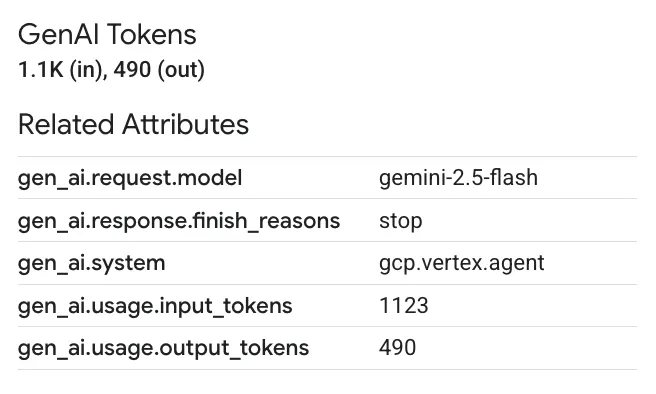
您可以藉此:
- 追蹤精細層級的費用:準確掌握每個代理程式和工具消耗的權杖數量。
- 找出最佳化機會:如果代理程式使用的權杖數量異常高,或許可以藉此機會調整提示,或改用較小且更具成本效益的模型來執行特定工作。
步驟 3:分析修正管道追蹤記錄
修正管道較為複雜,因為其中包含 LoopAgent。Cloud Trace 可讓您輕鬆瞭解這種疊代行為。
找出時距名稱包含「FixAttemptLoop」的追蹤記錄。
如果沒有,請執行測試指令碼,並在系統詢問是否要修正程式碼時,回答「是」。
檢查迴圈結構
追蹤記錄檢視畫面會清楚顯示迴圈的執行情況。如果修正迴圈在成功前執行了兩次,您會在 FixAttemptLoop 範圍下方看到兩個巢狀 loop_iteration 範圍,每個範圍都包含 CodeFixer、FixTestRunner 和 FixValidator 代理程式的完整週期。
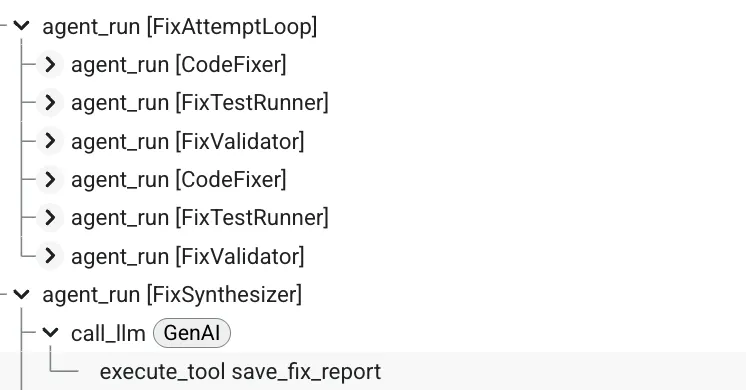
迴圈追蹤的主要觀察結果:
- 可見的疊代修正:您可以在
loop_iteration: 1中看到系統嘗試修正,並驗證修正結果,然後因為修正不夠完美,所以再次嘗試loop_iteration: 2。 - 可測量收斂情形:您可以比較每次疊代的持續時間和結果,瞭解系統如何收斂至正確的解決方案。
- 簡化偵錯程序:如果迴圈執行次數達到上限但仍失敗,您可以檢查每次疊代的狀態和代理程式行為,診斷修正內容無法收斂的原因。
這類詳細資料對於瞭解及偵錯實際工作環境中複雜的狀態迴圈行為,具有無可估量的價值。
步驟 4:你發現了什麼
成效模式
從檢查追蹤記錄中,您現在可以取得資料驅動的洞察資訊:
審查管道:
- 主要瓶頸:
Test Runner代理程式 (尤其是程式碼執行和以 LLM 為基礎的測試生成) 是審查過程中耗時最長的部分。 - 快速作業:確定性工具 (
analyze_code_structure) 和狀態管理作業速度極快,不會造成效能問題。
修正管道:
- 收斂率:您會發現大部分修正作業會在 1 到 2 次疊代中完成,這表示迴圈架構有效。
- 漸進式費用:由於 LLM 脈絡會隨著先前失敗嘗試的資訊而擴大,後續疊代可能需要較長時間。
費用驅動因素:
- 權杖消耗量:您可以找出哪些代理程式 (例如合成器) 需要最多權杖,並決定是否值得為該工作使用功能更強大但費用較高的模型。
如何查看問題
在正式環境中查看追蹤記錄時,請注意下列事項:
- 異常長的追蹤記錄:表示效能回歸或出現非預期的迴圈行為。
- 失敗的範圍 (標示為紅色):指出失敗的確切作業。
- 迴圈迭代次數過多 (超過 2 次):可能表示修正產生邏輯有問題。
- 高符記數:醒目顯示提示最佳化或模型選取變更的機會。
您學到的內容
透過 Cloud Trace,您現在瞭解如何:
✅ 要求流程視覺化:查看循序和迴圈式管道的完整執行路徑。
✅ 找出效能瓶頸:使用瀑布圖找出最慢的作業,並取得相關硬體資料。
✅ 分析迴圈行為:觀察迭代代理程式在多次嘗試後,如何收斂至解決方案。
✅ 追蹤權杖費用:檢查 LLM 範圍,以精細監控及最佳化權杖用量。
掌握基本概念
- 追蹤記錄和範圍:可觀測性的基本單位,代表要求和其中的作業。
- 瀑布式分析:解讀甘特圖,瞭解執行時間和依附元件。
- 找出重要路徑:找出決定整體延遲時間的作業序列。
- 精細的觀察能力:不只能掌握時間,還能瞭解每個作業的權杖計數等中繼資料,這些資料都會由 ADK 自動記錄。
後續步驟
繼續探索 Cloud Trace:
- 定期監控追蹤記錄,及早發現問題
- 比較追蹤記錄,找出效能衰退情形
- 根據追蹤資料做出最佳化決策
- 依時間長度篩選,找出速度緩慢的要求
進階可觀測性 (選用):
- 將追蹤記錄匯出至 BigQuery,進行複雜分析 (文件)
- 在 Cloud Monitoring 中建立自訂資訊主頁
- 設定效能下降快訊
- 將追蹤記錄與應用程式記錄建立關聯
9. 結論:從設計原型到投入正式環境
建構項目
您從七行程式碼開始,建構出可投入生產的 AI 代理系統:
# Where we started (7 lines)
agent = Agent(
model="gemini-2.5-flash",
instruction="Review Python code for issues"
)
# Where we ended (production system)
- Two distinct multi-agent pipelines (review and fix) built from 8 specialized agents.
- An iterative fix loop architecture for automated validation and retries.
- Real AST-based code analysis tools for deterministic, accurate feedback.
- Robust state management using the "constants pattern" for type-safe communication.
- Fully automated deployment to a managed, scalable cloud infrastructure.
- Complete, built-in observability with Cloud Trace for production monitoring.
掌握主要架構模式
模式 | 導入作業 | 對正式環境的影響 |
工具整合 | AST 分析、樣式檢查 | 實際驗證,而不只是 LLM 的意見 |
循序管道 | 檢查 → 修正工作流程 | 可預測且可偵錯的執行作業 |
迴圈架構 | 使用結束條件進行反覆修正 | 自我改進,直到成功為止 |
狀態管理 | 常數模式、三層記憶體 | 型別安全且可維護的狀態處理作業 |
正式版部署作業 | 透過 deploy.sh 建立的 Agent Engine | 代管式可擴充基礎架構 |
可觀測性 | 整合 Cloud Trace | 全面掌握生產行為 |
追蹤記錄的正式環境洞察資訊
Cloud Trace 資料揭露了重要洞察:
✅ 找出效能瓶頸:TestRunner 的 LLM 呼叫會導致延遲時間過長
✅ 工具效能:AST 分析執行時間為 100 毫秒 (表現優異)
✅ 成功率:修正迴圈會在 2 到 3 次疊代內收斂
✅ 權杖用量:每次審查約 600 個權杖,每次修正約 1800 個權杖
這些深入分析資料可做為持續改善的依據。
清除資源 (選用)
完成實驗後,如要避免產生費用,請按照下列步驟操作:
刪除 Agent Engine 部署作業:
import vertexai
client = vertexai.Client( # For service interactions via client.agent_engines
project="PROJECT_ID",
location="LOCATION",
)
RESOURCE_NAME = "projects/{PROJECT_ID}/locations/{LOCATION}/reasoningEngines/{RESOURCE_ID}"
client.agent_engines.delete(
name=RESOURCE_NAME,
force=True, # Optional, if the agent has resources (e.g. sessions, memory)
)
刪除 Cloud Run 服務 (如有):
gcloud run services delete code-review-assistant \
--region=$GOOGLE_CLOUD_LOCATION \
--quiet
刪除 Cloud SQL 執行個體 (如已建立):
gcloud sql instances delete your-project-db \
--quiet
清理儲存空間值區:
gsutil -m rm -r gs://your-project-staging
gsutil -m rm -r gs://your-project-artifacts
後續步驟
完成基礎設定後,請考慮進行下列強化措施:
- 新增其他語言:擴充工具,支援 JavaScript、Go、Java
- 與 GitHub 整合:自動審查提取要求
- 實作快取:縮短常見模式的延遲時間
- 新增專用代理程式:安全性掃描、效能分析
- 啟用 A/B 測試:比較不同模型和提示
- 匯出指標:將追蹤記錄傳送至專門的可觀測性平台
注意事項
- 從簡單開始,快速疊代:七行程式碼即可在可管理的步驟中投入生產
- 工具優於提示:實際 AST 分析優於「請檢查是否有錯誤」
- 狀態管理很重要:常數模式可避免錯別字錯誤
- 迴圈需要結束條件:請務必設定最大疊代次數和升級
- 透過自動化部署:deploy.sh 會處理所有複雜作業
- 觀測能力是不可或缺的:您無法改善無法評估的事物
持續學習的資源
繼續你的旅程
您不僅建構了程式碼審查助理,也掌握了建構任何正式版 AI 代理程式的模式:
✅ 包含多個專用代理程式的複雜工作流程
✅ 整合實際工具,提供真實功能
✅ 部署正式版,並妥善監控
✅ 進行狀態管理,確保系統可維護
這些模式的規模從簡單的助理到複雜的自主系統都有。您在這裡建立的基礎,將有助於您處理日益複雜的代理程式架構。
歡迎瞭解如何開發正式版 AI 代理程式。程式碼審查助理只是起點。

